Avaya K155 IP Phone User Manual Using Avaya Vantage and Avaya Vantage Basic
AVAYA IP Phone Using Avaya Vantage and Avaya Vantage Basic
Avaya >
User Manual

Using Avaya Vantage™ and Avaya
Vantage™ Basic
Release 2.0
Issue 1
June 2018
Avaya - Proprietary. Use pursuant to the terms of your signed agreement or Avaya policy.
DRAFT—May 15, 2018—3:13 PM (UTC)

© 2017-2018, Avaya Inc.1
All Rights Reserved.2
Note3
Using a cell, mobile, or GSM phone, or a two-way radio in close4
proximity to an Avaya IP telephone might cause interference.5
Documentation disclaimer6
“Documentation” means information published in varying mediums7
which may include product information, operating instructions and8
performance specifications that are generally made available to users9
of products. Documentation does not include marketing materials.10
Avaya shall not be responsible for any modifications, additions, or11
deletions to the original published version of Documentation unless12
such modifications, additions, or deletions were performed by or on13
the express behalf of Avaya. End User agrees to indemnify and hold14
harmless Avaya, Avaya's agents, servants and employees against all15
claims, lawsuits, demands and judgments arising out of, or in16
connection with, subsequent modifications, additions or deletions to17
this documentation, to the extent made by End User.18
Link disclaimer19
Avaya is not responsible for the contents or reliability of any linked20
websites referenced within this site or Documentation provided by21
Avaya. Avaya is not responsible for the accuracy of any information,22
statement or content provided on these sites and does not23
necessarily endorse the products, services, or information described24
or offered within them. Avaya does not guarantee that these links will25
work all the time and has no control over the availability of the linked26
pages.27
Warranty28
Avaya provides a limited warranty on Avaya hardware and software.29
Refer to your sales agreement to establish the terms of the limited30
warranty. In addition, Avaya’s standard warranty language, as well as31
information regarding support for this product while under warranty is32
available to Avaya customers and other parties through the Avaya33
Support website: https://support.avaya.com/helpcenter/34
getGenericDetails?detailId=C20091120112456651010 under the link35
“Warranty & Product Lifecycle” or such successor site as designated36
by Avaya. Please note that if You acquired the product(s) from an37
authorized Avaya Channel Partner outside of the United States and38
Canada, the warranty is provided to You by said Avaya Channel39
Partner and not by Avaya.40
“Hosted Service” means an Avaya hosted service subscription that41
You acquire from either Avaya or an authorized Avaya Channel42
Partner (as applicable) and which is described further in Hosted SAS43
or other service description documentation regarding the applicable44
hosted service. If You purchase a Hosted Service subscription, the45
foregoing limited warranty may not apply but You may be entitled to46
support services in connection with the Hosted Service as described47
further in your service description documents for the applicable48
Hosted Service. Contact Avaya or Avaya Channel Partner (as49
applicable) for more information.50
Hosted Service51
THE FOLLOWING APPLIES ONLY IF YOU PURCHASE AN AVAYA52
HOSTED SERVICE SUBSCRIPTION FROM AVAYA OR AN AVAYA53
CHANNEL PARTNER (AS APPLICABLE), THE TERMS OF USE54
FOR HOSTED SERVICES ARE AVAILABLE ON THE AVAYA55
WEBSITE, HTTPS://SUPPORT.AVAYA.COM/LICENSEINFO UNDER56
THE LINK “Avaya Terms of Use for Hosted Services” OR SUCH57
SUCCESSOR SITE AS DESIGNATED BY AVAYA, AND ARE58
APPLICABLE TO ANYONE WHO ACCESSES OR USES THE59
HOSTED SERVICE. BY ACCESSING OR USING THE HOSTED60
SERVICE, OR AUTHORIZING OTHERS TO DO SO, YOU, ON61
BEHALF OF YOURSELF AND THE ENTITY FOR WHOM YOU ARE62
DOING SO (HEREINAFTER REFERRED TO INTERCHANGEABLY63
AS “YOU” AND “END USER”), AGREE TO THE TERMS OF USE. IF64
YOU ARE ACCEPTING THE TERMS OF USE ON BEHALF A65
COMPANY OR OTHER LEGAL ENTITY, YOU REPRESENT THAT66
YOU HAVE THE AUTHORITY TO BIND SUCH ENTITY TO THESE67
TERMS OF USE. IF YOU DO NOT HAVE SUCH AUTHORITY, OR IF68
YOU DO NOT WISH TO ACCEPT THESE TERMS OF USE, YOU69
MUST NOT ACCESS OR USE THE HOSTED SERVICE OR70
AUTHORIZE ANYONE TO ACCESS OR USE THE HOSTED71
SERVICE.72
Licenses73
THE SOFTWARE LICENSE TERMS AVAILABLE ON THE AVAYA74
WEBSITE, HTTPS://SUPPORT.AVAYA.COM/LICENSEINFO,75
UNDER THE LINK “AVAYA SOFTWARE LICENSE TERMS (Avaya76
Products)” OR SUCH SUCCESSOR SITE AS DESIGNATED BY77
AVAYA, ARE APPLICABLE TO ANYONE WHO DOWNLOADS,78
USES AND/OR INSTALLS AVAYA SOFTWARE, PURCHASED79
FROM AVAYA INC., ANY AVAYA AFFILIATE, OR AN AVAYA80
CHANNEL PARTNER (AS APPLICABLE) UNDER A COMMERCIAL81
AGREEMENT WITH AVAYA OR AN AVAYA CHANNEL PARTNER.82
UNLESS OTHERWISE AGREED TO BY AVAYA IN WRITING,83
AVAYA DOES NOT EXTEND THIS LICENSE IF THE SOFTWARE84
WAS OBTAINED FROM ANYONE OTHER THAN AVAYA, AN AVAYA85
AFFILIATE OR AN AVAYA CHANNEL PARTNER; AVAYA86
RESERVES THE RIGHT TO TAKE LEGAL ACTION AGAINST YOU87
AND ANYONE ELSE USING OR SELLING THE SOFTWARE88
WITHOUT A LICENSE. BY INSTALLING, DOWNLOADING OR89
USING THE SOFTWARE, OR AUTHORIZING OTHERS TO DO SO,90
YOU, ON BEHALF OF YOURSELF AND THE ENTITY FOR WHOM91
YOU ARE INSTALLING, DOWNLOADING OR USING THE92
SOFTWARE (HEREINAFTER REFERRED TO93
INTERCHANGEABLY AS “YOU” AND “END USER”), AGREE TO94
THESE TERMS AND CONDITIONS AND CREATE A BINDING95
CONTRACT BETWEEN YOU AND AVAYA INC. OR THE96
APPLICABLE AVAYA AFFILIATE (“AVAYA”).97
Avaya grants You a license within the scope of the license types98
described below, with the exception of Heritage Nortel Software, for99
which the scope of the license is detailed below. Where the order100
documentation does not expressly identify a license type, the101
applicable license will be a Designated System License as set forth102
below in the Designated System(s) License (DS) section as103
applicable. The applicable number of licenses and units of capacity104
for which the license is granted will be one (1), unless a different105
number of licenses or units of capacity is specified in the106
documentation or other materials available to You. “Software” means107
computer programs in object code, provided by Avaya or an Avaya108
Channel Partner, whether as stand-alone products, pre-installed on109
hardware products, and any upgrades, updates, patches, bug fixes,110
or modified versions thereto. “Designated Processor” means a single111
stand-alone computing device. “Server” means a set of Designated112
Processors that hosts (physically or virtually) a software application113
to be accessed by multiple users. “Instance” means a single copy of114
the Software executing at a particular time: (i) on one physical115
machine; or (ii) on one deployed software virtual machine (“VM”) or116
similar deployment.117
License types118
Designated System(s) License (DS). End User may install and use119
each copy or an Instance of the Software only: 1) on a number of120
Designated Processors up to the number indicated in the order; or 2)121
up to the number of Instances of the Software as indicated in the122
order, Documentation, or as authorized by Avaya in writing. Avaya123
may require the Designated Processor(s) to be identified in the order124
by type, serial number, feature key, Instance, location or other125
specific designation, or to be provided by End User to Avaya through126
electronic means established by Avaya specifically for this purpose.127
Shrinkwrap License (SR). You may install and use the Software in128
accordance with the terms and conditions of the applicable license129
agreements, such as “shrinkwrap” or “clickthrough” license130
accompanying or applicable to the Software (“Shrinkwrap License”).131
Heritage Nortel Software132
“Heritage Nortel Software” means the software that was acquired by133
Avaya as part of its purchase of the Nortel Enterprise Solutions134
Business in December 2009. The Heritage Nortel Software is the135
software contained within the list of Heritage Nortel Products located136
at https://support.avaya.com/LicenseInfo under the link “Heritage137
Nortel Products” or such successor site as designated by Avaya. For138
Heritage Nortel Software, Avaya grants Customer a license to use139
Heritage Nortel Software provided hereunder solely to the extent of140
the authorized activation or authorized usage level, solely for the141
purpose specified in the Documentation, and solely as embedded in,142
for execution on, or for communication with Avaya equipment.143
Charges for Heritage Nortel Software may be based on extent of144
activation or use authorized as specified in an order or invoice.145

Copyright1
Except where expressly stated otherwise, no use should be made of2
materials on this site, the Documentation, Software, Hosted Service,3
or hardware provided by Avaya. All content on this site, the4
documentation, Hosted Service, and the product provided by Avaya5
including the selection, arrangement and design of the content is6
owned either by Avaya or its licensors and is protected by copyright7
and other intellectual property laws including the sui generis rights8
relating to the protection of databases. You may not modify, copy,9
reproduce, republish, upload, post, transmit or distribute in any way10
any content, in whole or in part, including any code and software11
unless expressly authorized by Avaya. Unauthorized reproduction,12
transmission, dissemination, storage, and or use without the express13
written consent of Avaya can be a criminal, as well as a civil offense14
under the applicable law.15
Virtualization16
The following applies if the product is deployed on a virtual machine.17
Each product has its own ordering code and license types. Note,18
unless otherwise stated, that each Instance of a product must be19
separately licensed and ordered. For example, if the end user20
customer or Avaya Channel Partner would like to install two21
Instances of the same type of products, then two products of that22
type must be ordered.23
Third Party Components24
“Third Party Components” mean certain software programs or25
portions thereof included in the Software or Hosted Service may26
contain software (including open source software) distributed under27
third party agreements (“Third Party Components”), which contain28
terms regarding the rights to use certain portions of the Software29
(“Third Party Terms”). As required, information regarding distributed30
Linux OS source code (for those products that have distributed Linux31
OS source code) and identifying the copyright holders of the Third32
Party Components and the Third Party Terms that apply is available33
in the products, Documentation or on Avaya’s website at: https://34
support.avaya.com/Copyright or such successor site as designated35
by Avaya. The open source software license terms provided as Third36
Party Terms are consistent with the license rights granted in these37
Software License Terms, and may contain additional rights benefiting38
You, such as modification and distribution of the open source39
software. The Third Party Terms shall take precedence over these40
Software License Terms, solely with respect to the applicable Third41
Party Components to the extent that these Software License Terms42
impose greater restrictions on You than the applicable Third Party43
Terms.44
The following applies only if the H.264 (AVC) codec is distributed with45
the product. THIS PRODUCT IS LICENSED UNDER THE AVC46
PATENT PORTFOLIO LICENSE FOR THE PERSONAL USE OF A47
CONSUMER OR OTHER USES IN WHICH IT DOES NOT RECEIVE48
REMUNERATION TO (i) ENCODE VIDEO IN COMPLIANCE WITH49
THE AVC STANDARD (“AVC VIDEO”) AND/OR (ii) DECODE AVC50
VIDEO THAT WAS ENCODED BY A CONSUMER ENGAGED IN A51
PERSONAL ACTIVITY AND/OR WAS OBTAINED FROM A VIDEO52
PROVIDER LICENSED TO PROVIDE AVC VIDEO. NO LICENSE IS53
GRANTED OR SHALL BE IMPLIED FOR ANY OTHER USE.54
ADDITIONAL INFORMATION MAY BE OBTAINED FROM MPEG LA,55
L.L.C. SEE HTTP://WWW.MPEGLA.COM.56
Service Provider57
THE FOLLOWING APPLIES TO AVAYA CHANNEL PARTNER’S58
HOSTING OF AVAYA PRODUCTS OR SERVICES. THE PRODUCT59
OR HOSTED SERVICE MAY USE THIRD PARTY COMPONENTS60
SUBJECT TO THIRD PARTY TERMS AND REQUIRE A SERVICE61
PROVIDER TO BE INDEPENDENTLY LICENSED DIRECTLY FROM62
THE THIRD PARTY SUPPLIER. AN AVAYA CHANNEL PARTNER’S63
HOSTING OF AVAYA PRODUCTS MUST BE AUTHORIZED IN64
WRITING BY AVAYA AND IF THOSE HOSTED PRODUCTS USE65
OR EMBED CERTAIN THIRD PARTY SOFTWARE, INCLUDING66
BUT NOT LIMITED TO MICROSOFT SOFTWARE OR CODECS,67
THE AVAYA CHANNEL PARTNER IS REQUIRED TO68
INDEPENDENTLY OBTAIN ANY APPLICABLE LICENSE69
AGREEMENTS, AT THE AVAYA CHANNEL PARTNER’S EXPENSE,70
DIRECTLY FROM THE APPLICABLE THIRD PARTY SUPPLIER.71
WITH RESPECT TO CODECS, IF THE AVAYA CHANNEL72
PARTNER IS HOSTING ANY PRODUCTS THAT USE OR EMBED73
THE G.729 CODEC, H.264 CODEC, OR H.265 CODEC, THE74
AVAYA CHANNEL PARTNER ACKNOWLEDGES AND AGREES75
THE AVAYA CHANNEL PARTNER IS RESPONSIBLE FOR ANY76
AND ALL RELATED FEES AND/OR ROYALTIES. THE G.72977
CODEC IS LICENSED BY SIPRO LAB TELECOM INC. SEE 78
WWW.SIPRO.COM/CONTACT.HTML. THE H.264 (AVC) CODEC IS79
LICENSED UNDER THE AVC PATENT PORTFOLIO LICENSE FOR80
THE PERSONAL USE OF A CONSUMER OR OTHER USES IN81
WHICH IT DOES NOT RECEIVE REMUNERATION TO: (I) ENCODE82
VIDEO IN COMPLIANCE WITH THE AVC STANDARD (“AVC83
VIDEO”) AND/OR (II) DECODE AVC VIDEO THAT WAS ENCODED84
BY A CONSUMER ENGAGED IN A PERSONAL ACTIVITY AND/OR85
WAS OBTAINED FROM A VIDEO PROVIDER LICENSED TO86
PROVIDE AVC VIDEO. NO LICENSE IS GRANTED OR SHALL BE87
IMPLIED FOR ANY OTHER USE. ADDITIONAL INFORMATION88
FOR H.264 (AVC) AND H.265 (HEVC) CODECS MAY BE89
OBTAINED FROM MPEG LA, L.L.C. SEE HTTP://90
WWW.MPEGLA.COM.91
Compliance with Laws92
You acknowledge and agree that it is Your responsibility for93
complying with any applicable laws and regulations, including, but not94
limited to laws and regulations related to call recording, data privacy,95
intellectual property, trade secret, fraud, and music performance96
rights, in the country or territory where the Avaya product is used.97
Preventing Toll Fraud98
“Toll Fraud” is the unauthorized use of your telecommunications99
system by an unauthorized party (for example, a person who is not a100
corporate employee, agent, subcontractor, or is not working on your101
company's behalf). Be aware that there can be a risk of Toll Fraud102
associated with your system and that, if Toll Fraud occurs, it can103
result in substantial additional charges for your telecommunications104
services.105
Avaya Toll Fraud intervention106
If You suspect that You are being victimized by Toll Fraud and You107
need technical assistance or support, call Technical Service Center108
Toll Fraud Intervention Hotline at +1-800-643-2353 for the United109
States and Canada. For additional support telephone numbers, see110
the Avaya Support website: https://support.avaya.com or such111
successor site as designated by Avaya.112
Security Vulnerabilities113
Information about Avaya’s security support policies can be found in114
the Security Policies and Support section of https://115
support.avaya.com/security.116
Suspected Avaya product security vulnerabilities are handled per the117
Avaya Product Security Support Flow (https://118
support.avaya.com/css/P8/documents/100161515).119
Downloading Documentation120
For the most current versions of Documentation, see the Avaya121
Support website: https://support.avaya.com, or such successor site122
as designated by Avaya.123
Contact Avaya Support124
See the Avaya Support website: https://support.avaya.com for125
product or Hosted Service notices and articles, or to report a problem126
with your Avaya product or Hosted Service. For a list of support127
telephone numbers and contact addresses, go to the Avaya Support128
website: https://support.avaya.com (or such successor site as129
designated by Avaya), scroll to the bottom of the page, and select130
Contact Avaya Support.131
Regulatory Statements132
Australia Statements133
Handset Magnets Statement: 134
Danger:
The handset receiver contains magnetic devices that can135
attract small metallic objects. Care should be taken to avoid136
personal injury.137
Industry Canada (IC) Statements138
RSS Standards Statement75
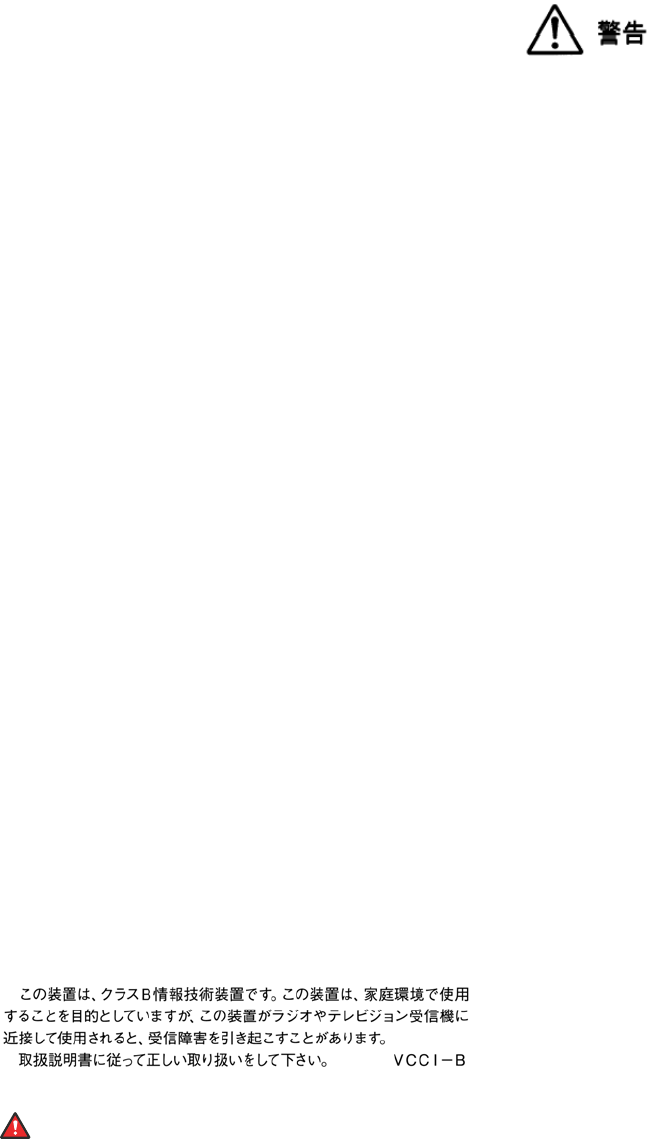
This device complies with Industry Canada licence-exempt RSS1
standard(s). Operation is subject to the following two conditions:2
1. This device may not cause interference, and3
2. This device must accept any interference, including4
interference that may cause undesired operation of the5
device.6
Le présent appareil est conforme aux CNR d'Industrie Canada7
applicables aux appareils radio exempts de licence. L'exploitation est8
autorisée aux deux conditions suivantes:9
1. L'appareil ne doit pas produire de brouillage, et10
2. L'utilisateur de l'appareil doit accepter tout brouillage11
radioélectrique subi, même si le brouillage est susceptible12
d'en compromettre le fonctionnement.13
Radio Transmitter Statement14
Under Industry Canada regulations, this radio transmitter may only15
operate using an antenna of a type and maximum (or lesser) gain16
approved for the transmitter by Industry Canada. To reduce potential17
radio interference to other users, the antenna type and its gain18
should be so chosen that the equivalent isotropically radiated power19
(EIRP) is not more than that necessary for successful20
communication.21
Conformément à la réglementation d'Industrie Canada, le présent22
émetteur radio peut fonctionner avec une antenne d'un type et d'un23
gain maximal (ou inférieur) approuvé pour l'émetteur par Industrie24
Canada. Dans le but de réduire les risques de brouillage25
radioélectrique à l'intention des autres utilisateurs, il faut choisir le26
type d'antenne et son gain de sorte que la puissance isotrope27
rayonnée équivalente ne dépasse pas l'intensité nécessaire à28
l'établissement d'une communication satisfaisante.29
This Class B digital apparatus complies with Canadian ICES-003.30
Cet appareil numérique de la classe B est conforme à la norme31
NMB-003 du Canada.32
Radiation Exposure Statement33
This equipment complies with FCC & IC RSS102 radiation exposure34
limits set forth for an uncontrolled environment. This equipment35
should be installed and operated with minimum distance 20cm36
between the radiator & your body. This transmitter must not be co-37
located or operating in conjunction with any other antenna or38
transmitter.39
Cet équipement est conforme aux limites d'exposition aux40
rayonnements ISEDétablies pour un environnement non contrôlé.41
Cet équipement doit être installé et utilisé avec un minimum de 2042
cm de distance entre la source de rayonnement et votre corps.43
Japan Statements44
Class B Statement45
This is a Class B product based on the standard of the VCCI Council.46
If this is used near a radio or television receiver in a domestic47
environment, it may cause radio interference. Install and use the48
equipment according to the instruction manual.49
50
Denan Power Cord Statement51
Danger:
Please be careful of the following while installing the52
equipment:53
•Please only use the connecting cables, power cord, and54
AC adapters shipped with the equipment or specified by55
Avaya to be used with the equipment. If you use any56
other equipment, it may cause failures, malfunctioning,57
or fire.58
• Power cords shipped with this equipment must not be59
used with any other equipment. In case the above60
guidelines are not followed, it may lead to death or61
severe injury.62
63
本製品を安全にご使用頂くため、以下のことにご注意ください。64
•接続ケーブル、電源コード、AC アダプタなどの部品は、必ず65
製品に同梱されております添付品または指定品をご使用くだ66
さい。添付品指定品以外の部品をご使用になると故障や動作67
不良、火災の原因となることがあります。68
•同梱されております付属の電源コードを他の機器には使用し69
ないでください。上記注意事項を守らないと、死亡や大怪我70
など人身事故の原因となることがあります。71
México Statement72
The operation of this equipment is subject to the following two73
conditions:74
1. It is possible that this equipment or device may not cause75
harmful interference, and76
2. This equipment or device must accept any interference,77
including interference that may cause undesired operation.78
La operación de este equipo está sujeta a las siguientes dos79
condiciones:80
1. Es posible que este equipo o dispositivo no cause81
interferencia perjudicial y82
2. Este equipo o dispositivo debe aceptar cualquier83
interferencia, incluyendo la que pueda causar su operación84
no deseada.85
Power over Ethernet (PoE) Statement86
This equipment must be connected to PoE networks without routing87
to the outside plant.88
U.S. Federal Communications Commission (FCC) Statements89
Compliance Statement90
The changes or modifications not expressly approved by the party91
responsible for compliance could void the user’s authority to operate92
the equipment.93
To comply with the FCC RF exposure compliance requirements, this94
device and its antenna must not be co-located or operating to95
conjunction with any other antenna or transmitter.96
This device complies with part 15 of the FCC Rules. Operation is97
subject to the following two conditions:98
1. This device may not cause harmful interference, and99
2. This device must accept any interference received,100
including interferences that may cause undesired101
operation.102
This equipment has been tested and found to comply with the limits103
for a Class B digital device, pursuant to Part 15 of the FCC Rules.104
These limits are designated to provide reasonable protection against105
harmful interferences in a residential installation. This equipment106
generates, uses and can radiate radio frequency energy and, if not107
installed and used in accordance with the instructions, may cause108
harmful interference to radio communications. However, there is no109
guarantee that interference will not occur in a particular installation. If110
this equipment does cause harmful interferences to radio or111
television reception, which can be determined by turning the112
equipment off and on, the user is encouraged to try to correct the113
interference by one or more of the following measures:114
• Reorient or relocate the receiving antenna.115
• Increase the separation between the equipment and receiver.116
• Connect the equipment into an outlet on a circuit different from117
that to which the receiver is connected.118
• Consult the dealer or an experienced radio/TV technician for61
help.62

Radiation Exposure Statement1
This equipment complies with FCC radiation exposure limits set forth2
for an uncontrolled environment . This equipment should be installed3
and operated with minimum distance of 8 in or 20 cm between the4
radiator and your body. This transmitter must not be co-located or5
operating in conjunction with any other antenna or transmitter.6
EU Countries7
This device when installed complies with the essential requirements8
and other relevant provisions of the EMC Directive 2014/30/EU,9
Safety LV Directive 2014/35/EU, and Radio Equipment Directive10
2014/53/EU. A copy of the Declaration may be obtained from http://11
support.avaya.com or Avaya Inc., 4655 Great America Parkway,12
Santa Clara, CA 95054–1233 USA.13
WiFi and BT transmitter14
• Frequencies for 2412-2472 MHz, transmit power: 19.84 dBm15
• Frequencies for 5180-5240 MHz, transmit power: 22.5 dBm16
General Safety Warning17
• Use only the Avaya approved Limited Power Source power18
supplies specified for this product.19
• Ensure that you:20
- Do not operate the device near water.21
- Do not use the device during a lightning storm.22
- Do not report a gas leak while in the vicinity of the leak.23
- For Accessory Power Supply - Use Only Limited Power24
Supply Delta Electronics Inc. model:ADP-30HR B , output:25
48Vdc, 0.66A.26
Trademarks27
The trademarks, logos and service marks (“Marks”) displayed in this28
site, the Documentation, Hosted Service(s), and product(s) provided29
by Avaya are the registered or unregistered Marks of Avaya, its30
affiliates, its licensors, its suppliers, or other third parties. Users are31
not permitted to use such Marks without prior written consent from32
Avaya or such third party which may own the Mark. Nothing33
contained in this site, the Documentation, Hosted Service(s) and34
product(s) should be construed as granting, by implication, estoppel,35
or otherwise, any license or right in and to the Marks without the36
express written permission of Avaya or the applicable third party.37
Avaya is a registered trademark of Avaya Inc.38
All non-Avaya trademarks are the property of their respective owners.39
Linux® is the registered trademark of Linus Torvalds in the U.S. and40
other countries.41
Android, Google and Google Play are trademarks of Google Inc.42
Contents
Chapter 1: Introduction............................................................................................................ 8
Purpose.................................................................................................................................. 8
Change history........................................................................................................................ 8
Chapter 2: Avaya Vantage™ overview..................................................................................... 9
Supported features................................................................................................................ 10
Wireless handset features................................................................................................ 11
Third party applications.......................................................................................................... 13
New in this release................................................................................................................ 13
Chapter 3: Getting started with Avaya Vantage™................................................................. 14
Installing applications............................................................................................................. 14
Logging in to and out of Avaya Vantage™................................................................................ 15
Locking and unlocking Avaya Vantage™.................................................................................. 15
Avaya Smart Lock................................................................................................................. 16
Enabling Avaya Smart Lock............................................................................................. 17
Removing or changing the trusted device.......................................................................... 18
Locking the device manually when Smart Lock is enabled.................................................. 19
Connecting a wireless handset............................................................................................... 19
Turning the wireless handset on and off............................................................................ 20
Chapter 4: Navigation............................................................................................................. 22
Physical device layout........................................................................................................... 22
Layout of Avaya Vantage™ K165 and K175........................................................................ 22
Layout of Avaya Vantage™ K155....................................................................................... 24
Connectors and controls.................................................................................................. 25
Wireless handset layout......................................................................................................... 28
Avaya Vantage Basic screen navigation.................................................................................. 28
Dial pad screen............................................................................................................... 28
Contacts screen.............................................................................................................. 30
Call screen..................................................................................................................... 32
Chapter 5: Call management operations.............................................................................. 35
Making audio or video calls.................................................................................................... 35
Making an emergency call................................................................................................ 35
Making an audio or video call using the dial pad................................................................ 36
Making an audio or video call using contacts..................................................................... 36
Making an audio or video call from your Favorites list......................................................... 36
Making an audio or video call using call history.................................................................. 37
Making a second call....................................................................................................... 37
Redialing a number......................................................................................................... 38
Managing calls...................................................................................................................... 38
Answering or declining an incoming call............................................................................ 38
June 2018 Using Avaya Vantage™ and Avaya Vantage™ Basic 6
Avaya - Proprietary. Use pursuant to the terms of your signed agreement or Avaya policy.
DRAFT—May 15, 2018—3:13 PM (UTC)
Entering digits during a call.............................................................................................. 39
Muting or unmuting a call................................................................................................. 39
Placing a call on hold and resuming the call...................................................................... 40
Toggling between calls..................................................................................................... 40
Transferring a call............................................................................................................ 40
Working with video functionality........................................................................................ 41
Selecting an active audio device....................................................................................... 41
Ending a call................................................................................................................... 42
Viewing call history................................................................................................................ 42
Deleting all call information............................................................................................... 43
Working with conference calls................................................................................................ 43
Starting a conference call................................................................................................. 43
Merging calls to create a conference call........................................................................... 43
Chapter 6: Contact management operations....................................................................... 45
Adding a contact................................................................................................................... 45
Editing a contact.................................................................................................................... 46
Deleting a contact.................................................................................................................. 46
Searching for a contact.......................................................................................................... 47
IP Office contact search options....................................................................................... 47
Setting contact display options............................................................................................... 47
Setting a contact as a favorite................................................................................................ 48
Synchronizing contacts and call history over Bluetooth............................................................. 48
Filtering contacts................................................................................................................... 49
Chapter 7: Customization...................................................................................................... 51
Modifying the ring tone........................................................................................................... 51
Disabling video using the privacy shutter................................................................................. 51
Changing the wallpaper......................................................................................................... 52
Chapter 8: Resources............................................................................................................. 53
Documentation...................................................................................................................... 53
Finding documents on the Avaya Support website............................................................. 53
Viewing Avaya Mentor videos................................................................................................. 54
Support................................................................................................................................ 54
Using the Avaya InSite Knowledge Base........................................................................... 54
Contents
June 2018 Using Avaya Vantage™ and Avaya Vantage™ Basic 7
Avaya - Proprietary. Use pursuant to the terms of your signed agreement or Avaya policy.
DRAFT—May 15, 2018—3:13 PM (UTC)
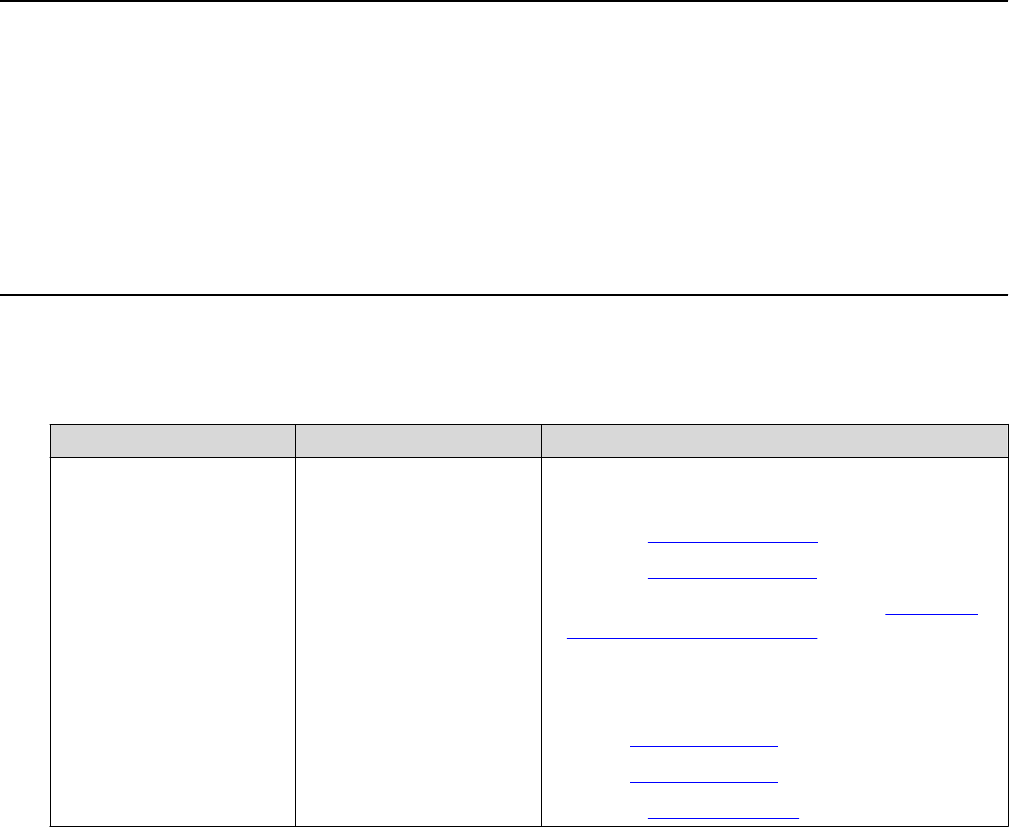
Chapter 1: Introduction1
Purpose2
This document is intended for end users and describes how to use the Avaya Vantage™ Basic3
application on an Avaya Vantage™ device. This document also describes setup tasks performed4
by end users.5
Separate documentation is available for SDK developer applications. This document does not6
provide information about SDK applications.7
Change history8
The following table describes the major changes made in this document:9
Issue Date Summary of changes
Release 2.0, Issue 1 June 2018 • Added information about the K155 device
throughout the document.
•Updated Supported features on page 10.
• Updated New in this release on page 13.
• Added IP Office login information in Logging in
to and out of Avaya Vantage on page 15.
•Updated the “Navigation” chapter.
• Minor rephrasing throughout the document.
• Added Editing a contact on page 46.
• Added Editing a contact on page 46.
• Updated Filtering contacts on page 49.
June 2018 Using Avaya Vantage™ and Avaya Vantage™ Basic 8
Avaya - Proprietary. Use pursuant to the terms of your signed agreement or Avaya policy.
DRAFT—May 15, 2018—3:13 PM (UTC)

Chapter 2: Avaya Vantage™ overview1
Avaya Vantage™ is an Android™ device that provides telephony and conferencing functionality.2
Avaya Vantage™ combines the advantages of a customizable unified communications solution and a3
fully functional Android device. Use the Avaya Breeze™ Client Software Development Kit (CSDK)4
and custom applications to integrate communications in business processes on your Avaya5
Vantage™ device.6
According to your business needs, you can choose from the following Avaya Vantage™ device7
variants:8
• Avaya Vantage™ K175: Standard device with an 8-inch screen and an integrated camera for full9
access to video calls and conferences. You can cover the camera by using a mechanical10
camera shutter.11
• Avaya Vantage™ K165: Standard device with an 8-inch screen that does not include an12
integrated camera. You can still receive video from other users.13
• Avaya Vantage™ K155: Device with a small 5-inch screen. The device also includes a dial pad14
and an integrated camera.15
Avaya Vantage™ supports the following communication applications:16
• Avaya Vantage™ Basic17
• Avaya Equinox®
18
• Avaya Vantage™ Open19
This document is focused on Avaya Vantage™ Basic usage. For more information about using other20
applications, see the following documents:21
• For more information about using Avaya Equinox® clients, see Using Avaya Equinox® for22
Android, iOS, Mac, and Windows.23
Some features and services are not supported when an Avaya Equinox® client is deployed on24
Avaya Vantage™. These feature discrepancies are described in the Avaya Equinox® clients25
documentation.26
• For more information about using Avaya Vantage™ Open, see Using Avaya Vantage™ Open.27
Note:
•IP Office Release 11.0 only supports Avaya Vantage™ Basic. IP Office Release 11.0 does28
not support other clients, such as Avaya Equinox®, on Avaya Vantage™.29
June 2018 Using Avaya Vantage™ and Avaya Vantage™ Basic 9
Avaya - Proprietary. Use pursuant to the terms of your signed agreement or Avaya policy.
DRAFT—May 15, 2018—3:13 PM (UTC)
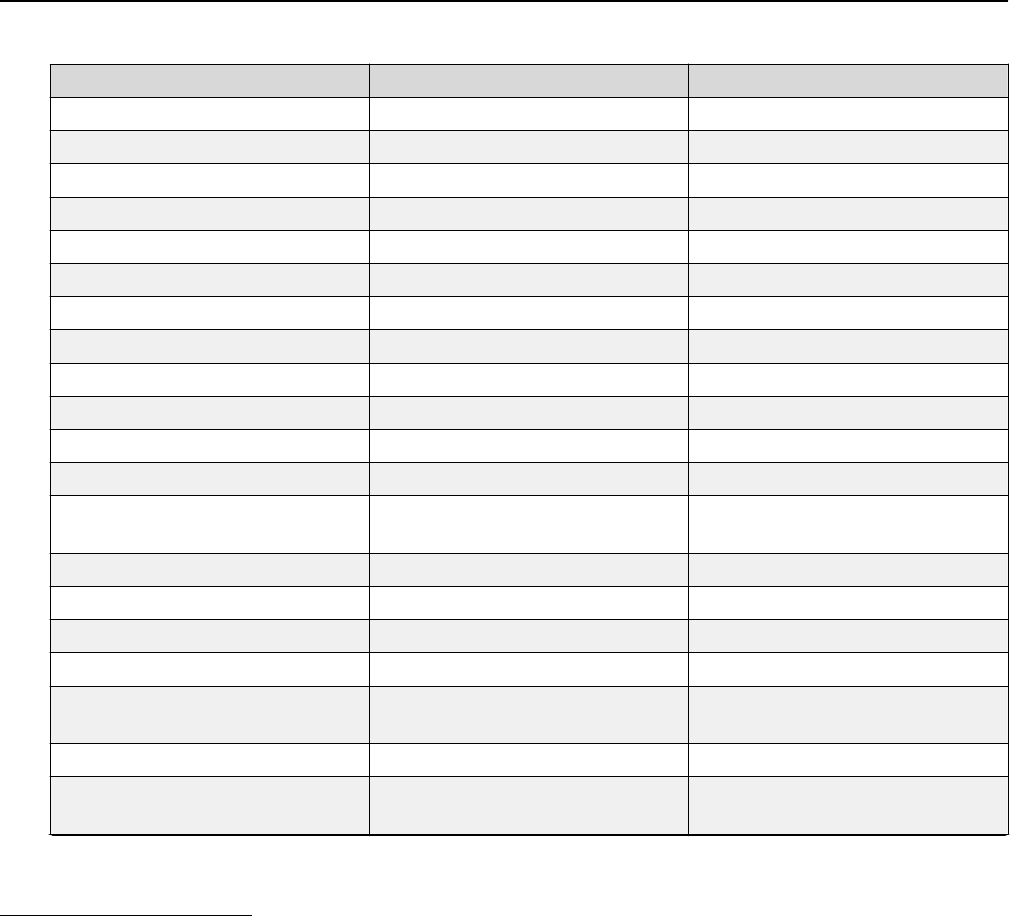
• In Release 2.0, the Avaya Vantage™ K155 device only supports Avaya Vantage™ Basic. It1
does not support Avaya Equinox® or Avaya Vantage™ Open.2
Supported features3
Avaya Vantage™ Basic feature Supported with Avaya Aura®Supported with IP Office
Make and receive audio calls Yes Yes
Caller ID and call information Yes Yes
Multiple line support Yes Yes1
Feature Access Codes (FACs)2Yes Yes
Mute calls Yes Yes
Hold calls Yes Yes
Transfer calls Yes Yes
Forward calls Yes, through FACs Yes, through FACs or short codes
Toggle calls Yes Yes
Conferencing Yes Yes
Missed calls indication Yes Yes
Do Not Disturb mode No No
Message Waiting Indication
(MWI)
Yes Yes
Video calls Yes Yes
Emergency calls Yes Yes3
Off Hook dialing Yes Yes
Call logs Yes Yes4
Avaya Aura® Device Services
contact services
Yes No
PPM contacts Yes No
Local contacts, including Google™
and Microsoft Exchange contacts
Yes Yes
Table continues…
1For multiple line support to work on IP Office, you must enable the Call Waiting On feature for the user account.
Otherwise the connection is treated as a single line.
2Avaya Vantage™ Basic does not have any UI representation for the FAC status. For example, if EC500 is enabled in the
Avaya Aura® environment, then the UI of Avaya Vantage™ Basic does not indicate that EC500 is enabled.
3In the IP Office environment, you can make an emergency call only when you are logged in to Avaya Vantage™. You
cannot make an emergency call from the Login screen. You can make an emergency call from the Lock screen if the
Lock mode is enabled and an administrator has configured emergency numbers in the 46xxspecial.txt file.
4Call logs in IP Office are local to the device.
Avaya Vantage™ overview
June 2018 Using Avaya Vantage™ and Avaya Vantage™ Basic 10
Avaya - Proprietary. Use pursuant to the terms of your signed agreement or Avaya policy.
DRAFT—May 15, 2018—3:13 PM (UTC)
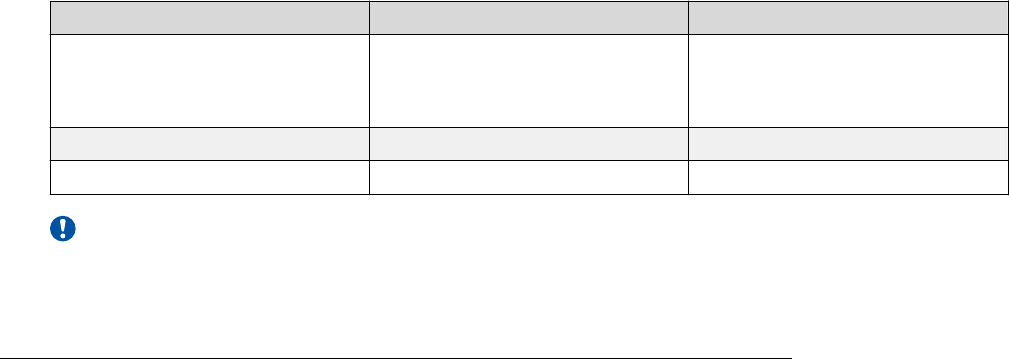
Avaya Vantage™ Basic feature Supported with Avaya Aura®Supported with IP Office
Favorites Yes Yes
Only local contacts can be added
to the Favorites list
Presence No No
Instant Messaging No No
Important:
IP Office Release 11.0 only supports Avaya Vantage™ Basic. Other applications, such as1
Avaya Equinox® on Avaya Vantage™, are not supported.2
3
Wireless handset features4
A wired or wireless handset can optionally be used with Avaya Vantage™. The following section5
describes the wireless handset features.6
Range7
The handset uses Bluetooth technology. As a Class 2 device, the handset nominal range is 108
meters. In practical use this range might vary depending on the environment. If the handset was9
out of range, the connection is reestablished automatically when the handset is back in range.10
When the handset is not in range for more than 22 minutes, it turns off to prevent battery11
discharge. If the handset was turned off, the connection is reestablished automatically when the12
handset is turned on and back in range.13
Battery service life14
If used carefully, the expected service life of the battery is several years. Although the battery15
capacity is diminished over time, in general it does not affect normal handset use.16
Battery talk time17
When fully charged, the new battery provides approximately 12 hours of talk time. You might need18
to charge the battery before the first use to achieve the full talk time. To prevent damage to the19
battery, the protection system does not allow the battery to discharge below a certain point. Avaya20
Vantage™ displays the battery charge level on the Notifications panel.21
Battery standby time22
When fully charged, the new battery provides approximately 60 hours of standby time. When the23
handset is not in range or Avaya Vantage™ is turned off for approximately 22 minutes, the handset24
is turned off automatically to save battery. To turn on the handset again, press the Power button25
for approximately 2 seconds. The handset is not turned on automatically even if it is returned to26
the cradle.27
Battery charging28
The handset supports a contactless charging system. To charge the handset, place it in its cradle.29
If the battery charge is low, the handset will notify you with warning tones. When you hear the30
warning tones, return the handset to its cradle to charge the battery.31
Supported features
June 2018 Using Avaya Vantage™ and Avaya Vantage™ Basic 11
Avaya - Proprietary. Use pursuant to the terms of your signed agreement or Avaya policy.
DRAFT—May 15, 2018—3:13 PM (UTC)
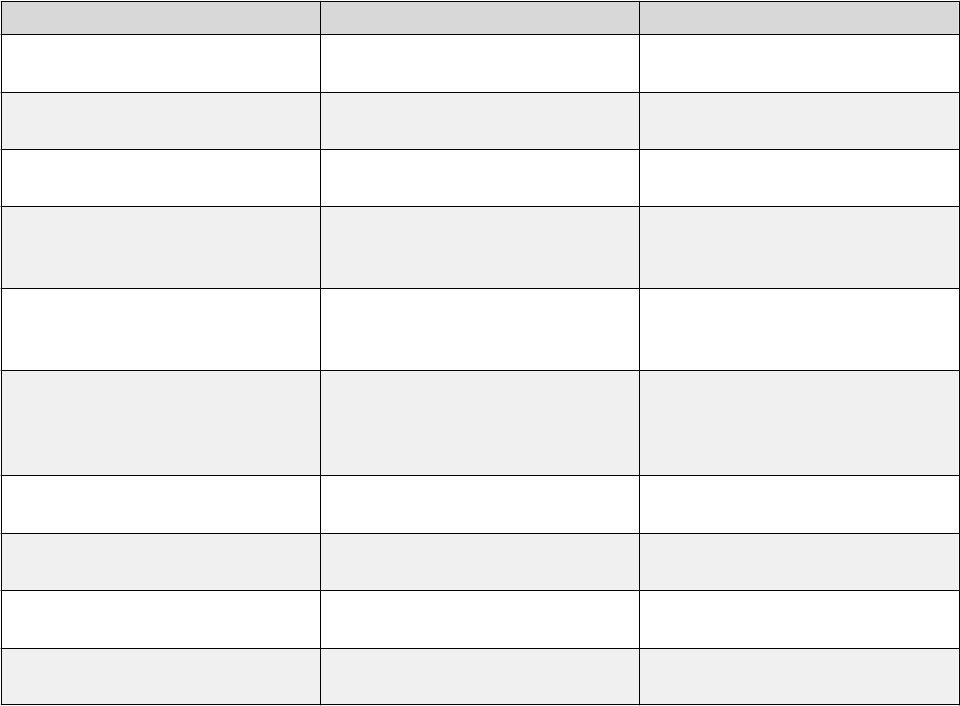
The handset uses a Lithium-Ion battery with the battery management and protection system. The1
protection system allows to prevent the following situations:2
•Overcharging.3
• Over-discharging.4
• Charging if the ambient temperature is higher than 40 °C (102 °F).5
Battery recharge time6
The battery fully recharges in less than 3 hours. You do not need to fully discharge the battery7
before charging.8
Battery disposal9
At the end of the service life, remove the battery and deliver it to a battery recycling depot. Do not10
dispose of the battery in the normal waste stream.11
Wireless handset LED indicator12
The blue LED indicator shows the current state of the handset and is also used to indicate user13
actions.14
Wireless handset state LED indication Notes
Wireless handset is in the Pairing
mode.
LED flashes every 0.5 seconds. Wireless handset exits the Pairing
mode in 150 seconds.
Pairing completed successfully. LED flashes 10 times at 0.1
seconds rate.
None
Wireless handset is used in a call LED flashes 3 times every 3
seconds
None
Wireless handset is turned on
and is connected to its base
(Connected mode).
LED flashes 2 times every 5
seconds.
None
Wireless handset is trying to
establish connection to its base
(Linkback mode).
LED flashes every 0.5 seconds. None
Wireless handset is out of range
and is not trying to establish
connection to its base (Standby
mode).
LED flashes every 5 seconds. Wireless handset is turned off
after 22 minutes.
Incoming call. LED flashes 3 times every 7
seconds.
None
Mute. LED is on and flashes 3 times
every 4 seconds.
None
Wireless handset has been
turned on.
LED flashes 4 times. None
Wireless handset has been
turned off.
LED flashes 3 times. None
Avaya Vantage™ overview
June 2018 Using Avaya Vantage™ and Avaya Vantage™ Basic 12
Avaya - Proprietary. Use pursuant to the terms of your signed agreement or Avaya policy.
DRAFT—May 15, 2018—3:13 PM (UTC)

Third party applications1
You can install third party applications on Google Play™. The system administrator determines the2
list of applications that you are allowed to install.3
New in this release4
Avaya Vantage™ Release 2.0 introduces the K155 device. This device includes a 5-inch screen5
and a key pad. Currently, only Avaya Vantage™ Basic is supported on the K155 device.6
Third party applications
June 2018 Using Avaya Vantage™ and Avaya Vantage™ Basic 13
Avaya - Proprietary. Use pursuant to the terms of your signed agreement or Avaya policy.
DRAFT—May 15, 2018—3:13 PM (UTC)

Chapter 3: Getting started with Avaya1
Vantage™
2
This chapter describes general startup tasks, such as logging in or out, locking your Avaya3
Vantage™ device, and enabling the Avaya Smart Lock feature. To enable the Avaya Smart Lock4
feature, you must first log in to your device manually.5
Installing applications6
About this task7
You can install applications from Google Play.8
Note:
•You can use this procedure to install Avaya Vantage™ Basic, Avaya Equinox®, or Avaya9
Vantage™ Open if these applications were not pre-installed by your administrator.10
• Your installation policy might prevent you from installing certain applications.11
Before you begin12
•Ensure that you have a Google account to access Google Play.13
• Work with your administrator to obtain permission to install applications on your Avaya14
Vantage™ device.15
Procedure16
1. On your device open Google Play.17
2. In the Search bar, enter the appropriate search term and then tap .18
For example, to find Avaya Vantage™ Basic, enter Avaya Vantage Basic.19
3. From the displayed search results, open the application page.20
4. Install the application.21
5. (Optional) If you want to set the installed telephony application as your primary telephony22
application, contact your administrator.23
Some Avaya applications, such as Avaya Vantage™ Basic or Avaya Equinox®, require24
additional setup performed by your administrator. Contact your administrator to see if the25
installed application requires additional setup.26
June 2018 Using Avaya Vantage™ and Avaya Vantage™ Basic 14
Avaya - Proprietary. Use pursuant to the terms of your signed agreement or Avaya policy.
DRAFT—May 15, 2018—3:13 PM (UTC)

Logging in to and out of Avaya Vantage™
1
About this task2
Use this procedure to log in to the Avaya Vantage™ device manually. You can log in to the device3
by using either SIP or Avaya Aura® Device Services credentials.4
After the first login, you can activate the Avaya Smart Lock feature. The Avaya Vantage™ device5
then automatically logs you in when you are within the range of the device while carrying a trusted6
device.7
Note:
This procedure is only applicable to Avaya Vantage™ Basic and Avaya Equinox®, but not to8
other telephony applications, such as Avaya Vantage™ Open.9
Procedure10
• To log in, do the following:11
1. In Username, enter your SIP or Avaya Aura® Device Services user name.12
In an IP Office environment, you must enter your SIP extension number.13
2. In Password, enter your user password.14
3. Tap Login.15
If you are using Avaya Aura® Device Services credentials, you might also need to enter16
your SIP credentials.17
4. (Optional) At the first login, accept the software license agreement.18
Avaya Vantage™ displays the Home screen or the main screen of the active telephony19
application depending on the settings configured by your system administrator.20
• To log out, do one of the following:21
- Swipe down to open the notification area, and tap Logout ( ).22
-On the Home screen, tap Logout ( ).23
-In Settings > System, tap Logout.24
Related links25
Enabling Avaya Smart Lock on page 1726
Locking and unlocking Avaya Vantage™
27
About this task28
Use this procedure to lock and unlock the Avaya Vantage™ device manually. You can lock the29
device for security and privacy reasons. Locking your phone does not log you out, so you can30
continue to receive calls.31
Logging in to and out of Avaya Vantage™
June 2018 Using Avaya Vantage™ and Avaya Vantage™ Basic 15
Avaya - Proprietary. Use pursuant to the terms of your signed agreement or Avaya policy.
DRAFT—May 15, 2018—3:13 PM (UTC)
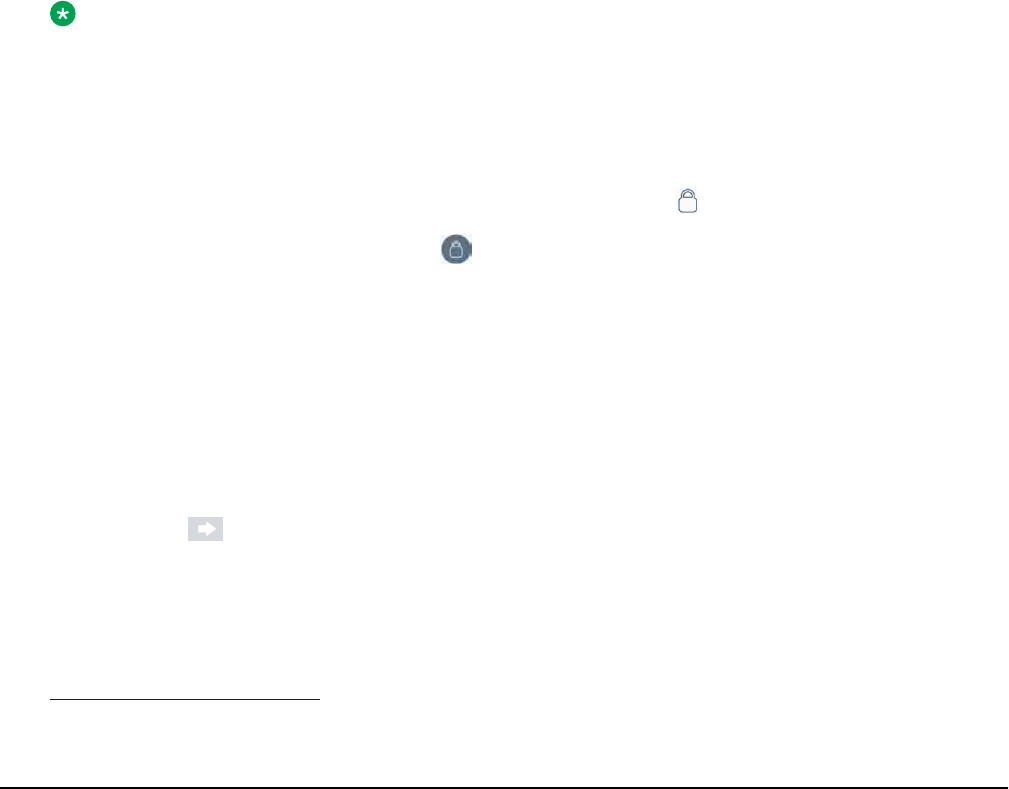
You can activate the Screen Lock feature so that the device is locked automatically after a period1
of inactivity. With IP Office deployments, this feature is disabled by default.2
You can also activate the Avaya Smart Lock feature. The Avaya Vantage™ device then3
automatically unlocks when you are within the range of the device while carrying a trusted4
Bluetooth device. When the trusted device goes out of range, the Avaya Vantage™ device is5
locked automatically.6
Note:
This procedure is only applicable to Avaya Vantage™ Basic and Avaya Equinox®, but not for7
other telephony applications, such as Avaya Vantage™ Open.8
Procedure9
• To lock the device, do one of the following:10
-Swipe down to open the notification area, and tap Lock ( ).11
-On the Home screen, tap Lock ( ).12
•To unlock the device, do the following:13
1. On the locked screen, swipe up to open the login prompt.14
2. In the Enter Password field, enter your SIP or Avaya Aura® Device Services password.15
- If login is performed using SIP credentials, enter the SIP password.16
- If login is performed using Avaya Aura® Device Services credentials, enter the Avaya17
Aura® Device Services password.18
3. Tap .19
When the device is unlocked successfully, Avaya Vantage™ displays the Home screen or the20
main screen of the active telephony application depending on the settings configured by your21
system administrator.22
Related links23
Enabling Avaya Smart Lock on page 1724
Avaya Smart Lock25
When Avaya Smart Lock is enabled, the Avaya Vantage™ device can automatically get unlocked26
and log you in without the need to enter your account credentials. The automatic login or unlock27
happens based on the proximity of the device to a trusted Bluetooth device. When the trusted28
device goes out of range, the Avaya Vantage™ device is locked automatically, and if configured,29
you are automatically logged out of the device.30
You can have your phone stay unlocked whenever it is connected to a trusted device.31
Getting started with Avaya Vantage™
June 2018 Using Avaya Vantage™ and Avaya Vantage™ Basic 16
Avaya - Proprietary. Use pursuant to the terms of your signed agreement or Avaya policy.
DRAFT—May 15, 2018—3:13 PM (UTC)

Bluetooth device as the trusted device1
You can choose any Bluetooth device, such as Bluetooth headsets, watches, or Bluetooth-2
enabled Android smart phones, as the trusted device. However, you cannot select the Avaya3
Vantage™ wireless Bluetooth handset as the trusted device. When choosing your trusted device,4
avoid using a device that is always with your Avaya Vantage™ device. For example, if you always5
have a Bluetooth keyboard and mouse with Avaya Vantage™, do not use this as your trusted6
device.7
Note that only one device can be set as the trusted device.8
Bluetooth connectivity range9
The Bluetooth connectivity range can vary based on factors, such as your device model, the10
Bluetooth device, and the current environment. Bluetooth connectivity of the Avaya Vantage™
11
device can be up to 10 meters.12
Avaya Smart Lock vs. Google Smart Lock13
• Avaya Smart Lock can automatically log you in or out of the Avaya Vantage™ device. Google14
Smart Lock does not support this capability.15
• Google Smart Lock does not support an Android smart phone as the trusted device.16
17
Enabling Avaya Smart Lock18
About this task19
Use this procedure to enable the Avaya Smart Lock feature. You can set your Avaya Vantage™
20
device to automatically unlock in certain circumstances, so you do not need to manually unlock21
the device with your PIN or password.22
Before you begin23
• On the Avaya Vantage™ device, turn on Bluetooth.24
• Pair a Bluetooth device to use as your trusted device.25
Procedure26
To enable the Avaya Smart Lock feature, do the following:27
1. Open the Settings menu.28
2. Tap Security > Trust agents.29
3. Turn on Avaya Smart Lock and tap Back ( ).30
By default, Google Smart Lock is enabled on Avaya Vantage™. Since you can enable only31
one trust agent at a time, Google Smart Lock is disabled automatically when you enable32
Avaya Smart Lock.33
To set up automatic unlock options and add the trusted device, do the following:34
4. Tap Security > Avaya Smart Lock.35
Avaya Smart Lock or Google Smart Lock are available only when the Screen lock36
feature is enabled.37
Avaya Smart Lock
June 2018 Using Avaya Vantage™ and Avaya Vantage™ Basic 17
Avaya - Proprietary. Use pursuant to the terms of your signed agreement or Avaya policy.
DRAFT—May 15, 2018—3:13 PM (UTC)

5. Enter the password that you use to log in and unlock Avaya Vantage™.1
6. In the Avaya Smart Lock menu, select one of the following lock options:2
•Unlock/Lock: When the trusted device is within range, the Avaya Vantage™ device3
unlocks automatically. When the trusted device goes out of range, the Avaya Vantage™
4
device is locked automatically.5
•Login and Unlock/Logout: When the trusted device is within the range, the Avaya6
Vantage™ device unlocks, and if required, logs you in automatically. When the trusted7
device goes out of range, the Avaya Vantage™ device is locked and you are8
automatically logged out of the device.9
After a logout, another user can log in to the device. When a new user logs in, all10
previous user data is wiped.11
7. Tap Trust Device.12
8. On the list of paired and connected devices, tap the device that you want to select as the13
trusted device.14
On the Lock screen, you see the Lock ( ) icon with a pulsing circle at the bottom. The 15
icon indicates that the device is unlocked. When the trusted device is within range, the16
device remains unlocked until you manually lock it.17
To access the device Home screen from the Lock screen, do the following:18
9. Swipe up the icon.19
You see the icon only when Smart Lock is set up and the trusted device is within range.20
21
Removing or changing the trusted device22
Procedure23
1. Open the Settings menu.24
2. Tap Security > Avaya Smart Lock.25
3. Enter the password that you use to log in and unlock Avaya Vantage™.26
4. Tap Trust Device.27
5. On the list of paired and connected devices, do one of the following:28
• To select a new device as the trusted device, tap the device name.29
• To remove the trusted device, tap None.30
Getting started with Avaya Vantage™
June 2018 Using Avaya Vantage™ and Avaya Vantage™ Basic 18
Avaya - Proprietary. Use pursuant to the terms of your signed agreement or Avaya policy.
DRAFT—May 15, 2018—3:13 PM (UTC)
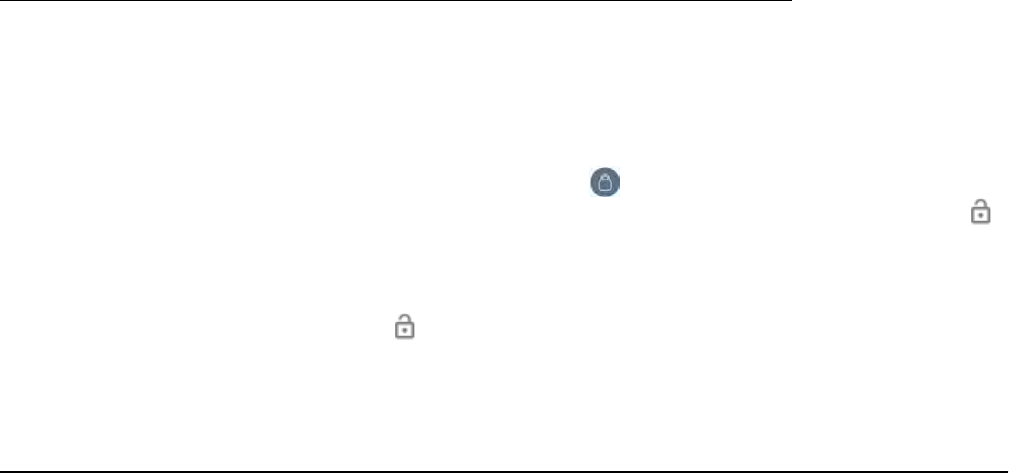
1
Locking the device manually when Smart Lock is enabled2
About this task3
Use this procedure to manually lock your Avaya Vantage™ device when Avaya Smart Lock is set4
up and the trusted device is within range.5
When the trusted device is within range, tapping Lock ( ) from the Home screen or from the6
notification area does not lock the device. The device displays the Lock screen with the Lock ( )7
icon.8
Procedure9
On the Lock screen, tap the Lock ( ) icon.10
The device stays locked until you manually unlock it with your account password.11
Connecting a wireless handset12
About this task13
Use this procedure to connect or pair a wireless handset with your Avaya Vantage™ device. You14
cannot use the wired handset after you connect the wireless handset. You can connect only one15
wireless handset at a time.16
You need administrative privilege to remove the pairing with the wireless handset.17
Before you begin18
• Charge the handset battery by placing the handset in the cradle.19
• Turn off the wireless handset.20
Procedure21
1. Lift the wireless handset from the cradle, and press and hold the top Power button for at22
least 10 seconds to enter the pairing mode.23
Connecting a wireless handset
June 2018 Using Avaya Vantage™ and Avaya Vantage™ Basic 19
Avaya - Proprietary. Use pursuant to the terms of your signed agreement or Avaya policy.
DRAFT—May 15, 2018—3:13 PM (UTC)
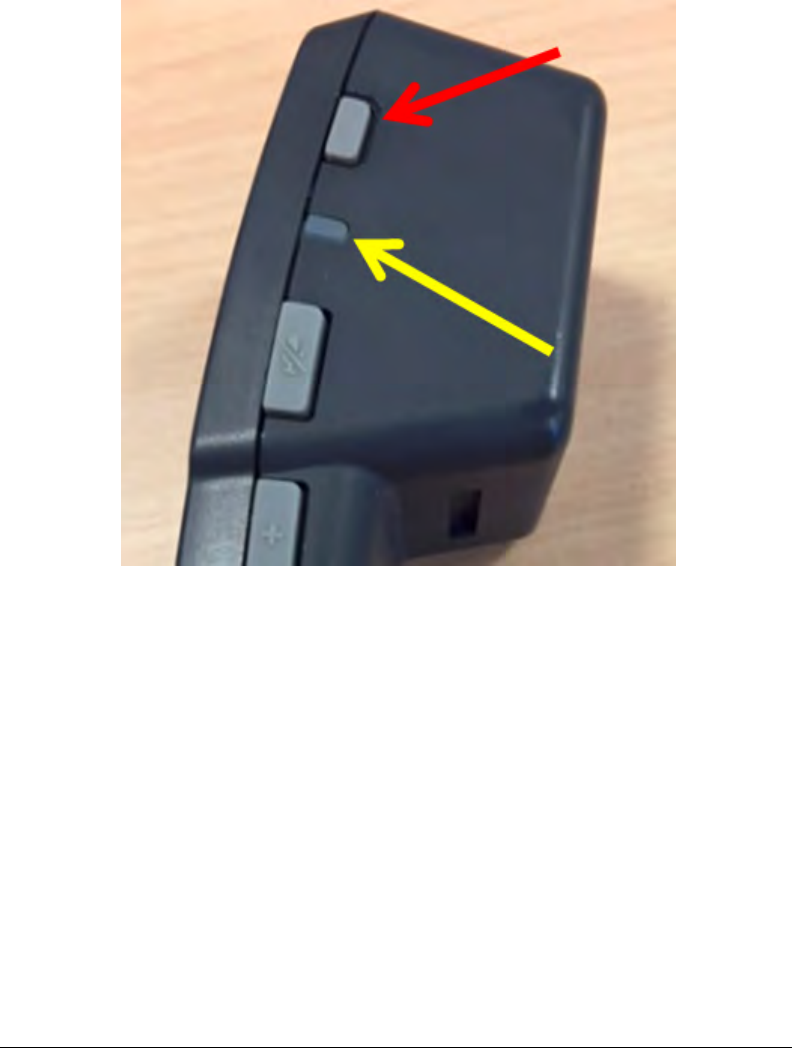
1
To indicate that the handset is in the pairing mode, the handset LED starts flashing.2
2. On the Home screen, tap Applications.3
3. Tap Settings.4
4. Tap Bluetooth.5
5. Turn Bluetooth on.6
6. In the list of available devices, tap the entry that matches the ID on the handset label.7
When pairing is successful, Avaya Vantage™ displays the wireless handset in the list of8
paired devices as connected.9
Result10
You can now use your wireless handset for calls as long as the handset is turned on. When the11
handset is turned off, you cannot use it for calls, but it is still paired with Avaya Vantage™. When12
you turn on the handset the next time, you do not need to repeat the pairing procedure.13
14
Turning the wireless handset on and off15
About this task16
Your system administrator might connect an optional wireless handset to your Avaya Vantage™. To17
use the handset, you must turn it on.18
Getting started with Avaya Vantage™
June 2018 Using Avaya Vantage™ and Avaya Vantage™ Basic 20
Avaya - Proprietary. Use pursuant to the terms of your signed agreement or Avaya policy.
DRAFT—May 15, 2018—3:13 PM (UTC)
When the handset is turned on, the handset LED flashes every 5 seconds. When the handset is1
not being used on a call and is not in its cradle, it automatically turns off in 60 seconds.2
Procedure3
To turn the wireless handset on or off, press the Power button for approximately 3 seconds.4
- When the handset turns on, the handset LED flashes 4 times.5
- When the handset turns off, the handset LED flashes 3 times.6
Connecting a wireless handset
June 2018 Using Avaya Vantage™ and Avaya Vantage™ Basic 21
Avaya - Proprietary. Use pursuant to the terms of your signed agreement or Avaya policy.
DRAFT—May 15, 2018—3:13 PM (UTC)

Chapter 4: Navigation1
Physical device layout2
You can choose from the following Avaya Vantage™ device variants:3
• Avaya Vantage™ K175: Standard device with an 8-inch screen and an integrated camera for4
full access to video calls and conferences. You can cover the camera by using a mechanical5
camera shutter.6
• Avaya Vantage™ K165: Standard device with an 8-inch screen that does not include an7
integrated camera. You can still receive video from other users.8
• Avaya Vantage™ K155: Device with a small 5-inch screen. The device also includes a dial9
pad and an integrated camera.10
11
Layout of Avaya Vantage™ K165 and K17512
The standard Avaya Vantage™ device resembles a tablet in the portrait orientation. The only13
difference in the layout of the Avaya Vantage™ K165 and K175 variants is that K175 comes with14
an integrated camera and a mechanical camera shutter.15
June 2018 Using Avaya Vantage™ and Avaya Vantage™ Basic 22
Avaya - Proprietary. Use pursuant to the terms of your signed agreement or Avaya policy.
DRAFT—May 15, 2018—3:13 PM (UTC)
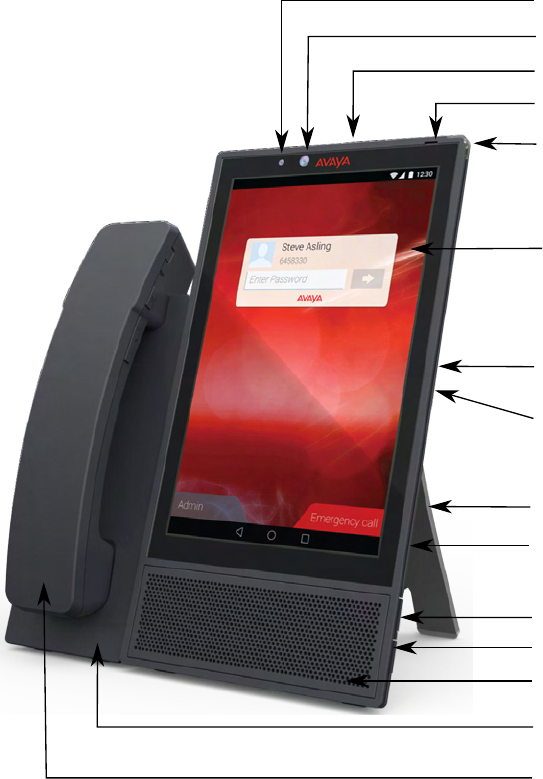
Camera (K175 only)
Camera shutter (K175 only)
Message waiting
indicator
USB Type-C port
Volume up
Volume down
Speaker
Microphone
Stand
Kensington lock slot
3.5 mm stereo
headset jack
Camera activity indicator (K175 only)
Wired or wireless handset
(optional)
Handset cradle
(optional)
Screen
1
Physical device layout
June 2018 Using Avaya Vantage™ and Avaya Vantage™ Basic 23
Avaya - Proprietary. Use pursuant to the terms of your signed agreement or Avaya policy.
DRAFT—May 15, 2018—3:13 PM (UTC)
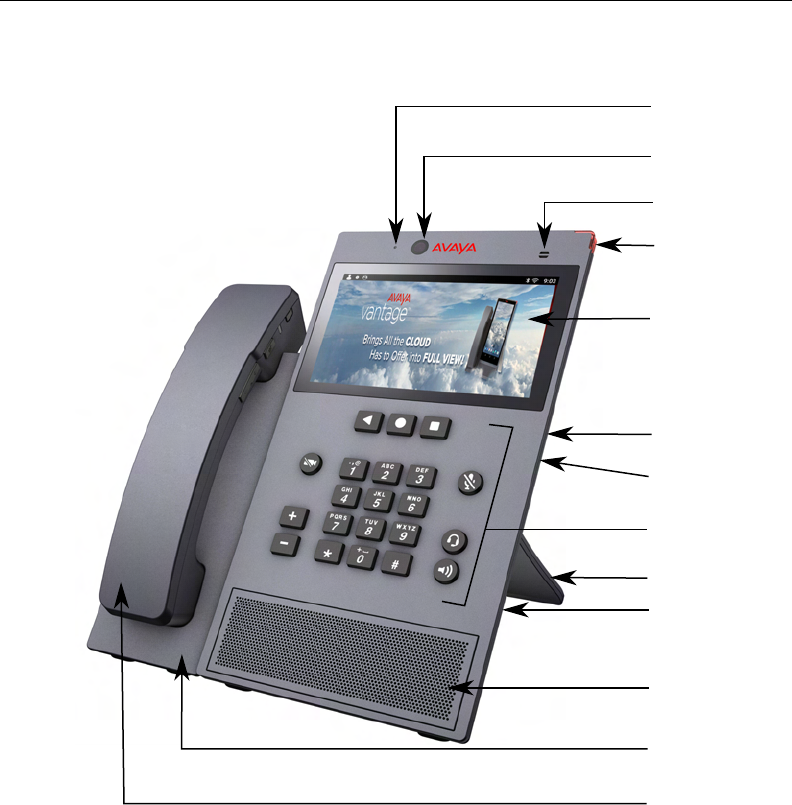
1
Layout of Avaya Vantage™ K1552
Camera
Message waiting
indicator
USB Type-A port
Speaker
Microphone
Stand
Kensington lock slot
3.5 mm stereo
headset jack
Camera activity indicator
Touch screen
Wired or wireless handset
(optional)
Handset cradle
(optional)
Dial pad and
functional keys
3
Dial pad and functional keys4
The Avaya Vantage™ K155 device includes a physical dial pad and functional keys.5
Navigation
June 2018 Using Avaya Vantage™ and Avaya Vantage™ Basic 24
Avaya - Proprietary. Use pursuant to the terms of your signed agreement or Avaya policy.
DRAFT—May 15, 2018—3:13 PM (UTC)
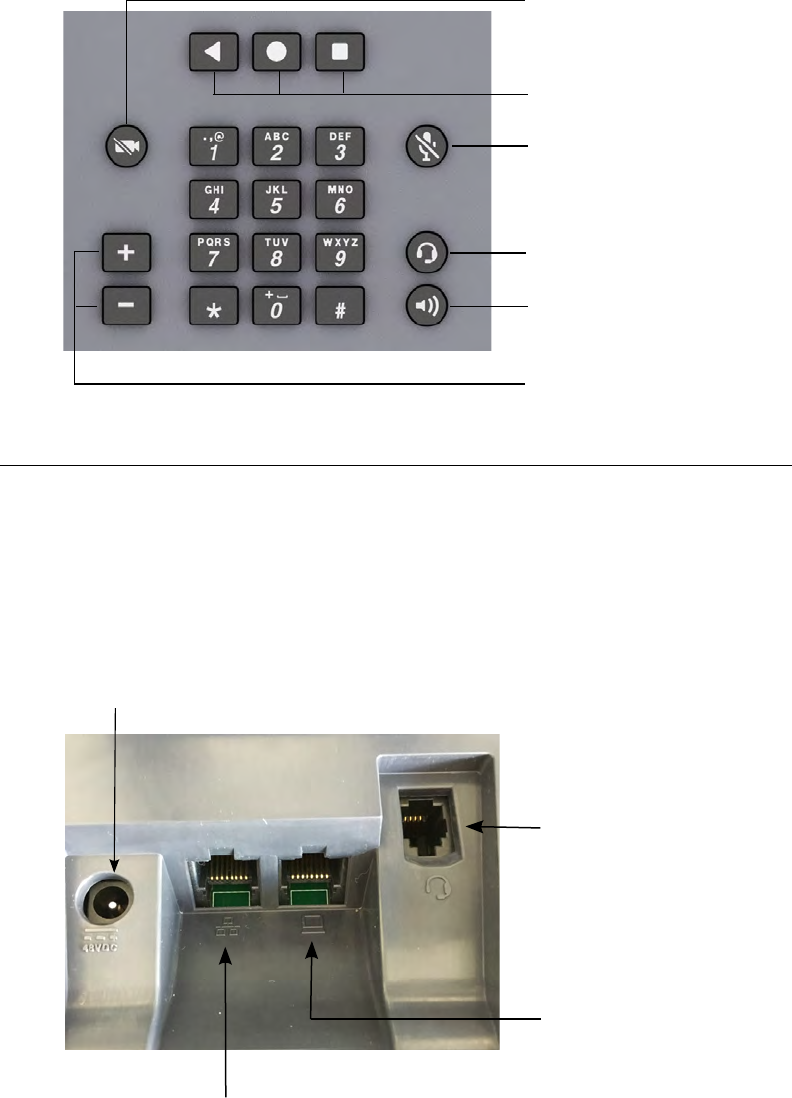
Video mute
Android navigation keys
Audio mute
Headset
Speaker
Volume
1
2
Connectors and controls3
The following images show the options available on the Avaya Vantage™ device.4
Rear panel5
The rear panel contains a power adapter connector, an RJ9 headset port, and dual Ethernet ports6
with an internal Ethernet switch.7
Power adapter connector
RJ9 analog
headset port
RJ45 PC port
RJ45 PoE LAN port
8
Physical device layout
June 2018 Using Avaya Vantage™ and Avaya Vantage™ Basic 25
Avaya - Proprietary. Use pursuant to the terms of your signed agreement or Avaya policy.
DRAFT—May 15, 2018—3:13 PM (UTC)
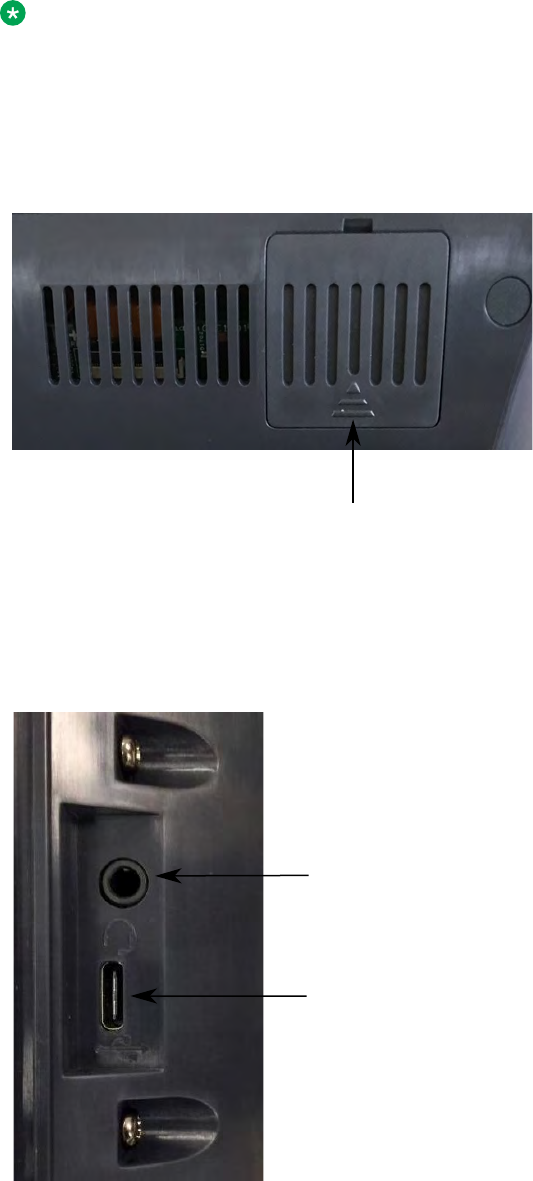
Note:
Avaya Vantage™ K165 and K175 devices from Release 1.0 only have a single Ethernet port.1
Devices with hardware version 5 and later support dual Ethernet ports.2
The K155 device has dual Ethernet ports.3
K155 devices have an additional wireless module slot at the top-right side of the rear panel. The4
wireless module provides Wi-Fi and Bluetooth connectivity.5
Slot for wireless module
6
Right side panel7
On Avaya Vantage™ K165 and K175, the right side panel contains a 3.5 mm audio jack socket and8
a USB Type-C port.9
3.5 mm stereo headset jack
with microphone support
USB Type-C
port
10
Navigation
June 2018 Using Avaya Vantage™ and Avaya Vantage™ Basic 26
Avaya - Proprietary. Use pursuant to the terms of your signed agreement or Avaya policy.
DRAFT—May 15, 2018—3:13 PM (UTC)
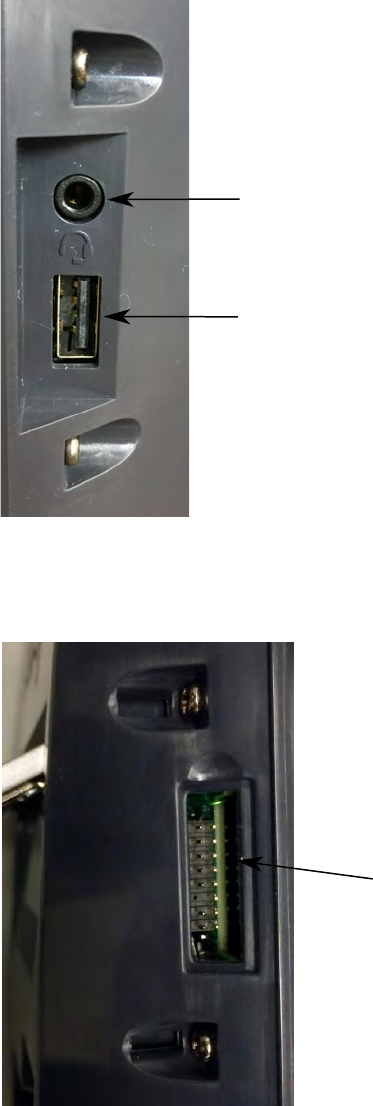
On Avaya Vantage™ K155, the right side panel contains a 3.5 mm audio jack socket and a USB1
Type-A port.2
3.5 mm stereo headset jack
with microphone support
USB Type-A
port
3
Left side panel4
On all device variants, the left side panel contains a cordless or corded handset cradle connector.5
Handset cradle connector
6
Physical device layout
June 2018 Using Avaya Vantage™ and Avaya Vantage™ Basic 27
Avaya - Proprietary. Use pursuant to the terms of your signed agreement or Avaya policy.
DRAFT—May 15, 2018—3:13 PM (UTC)
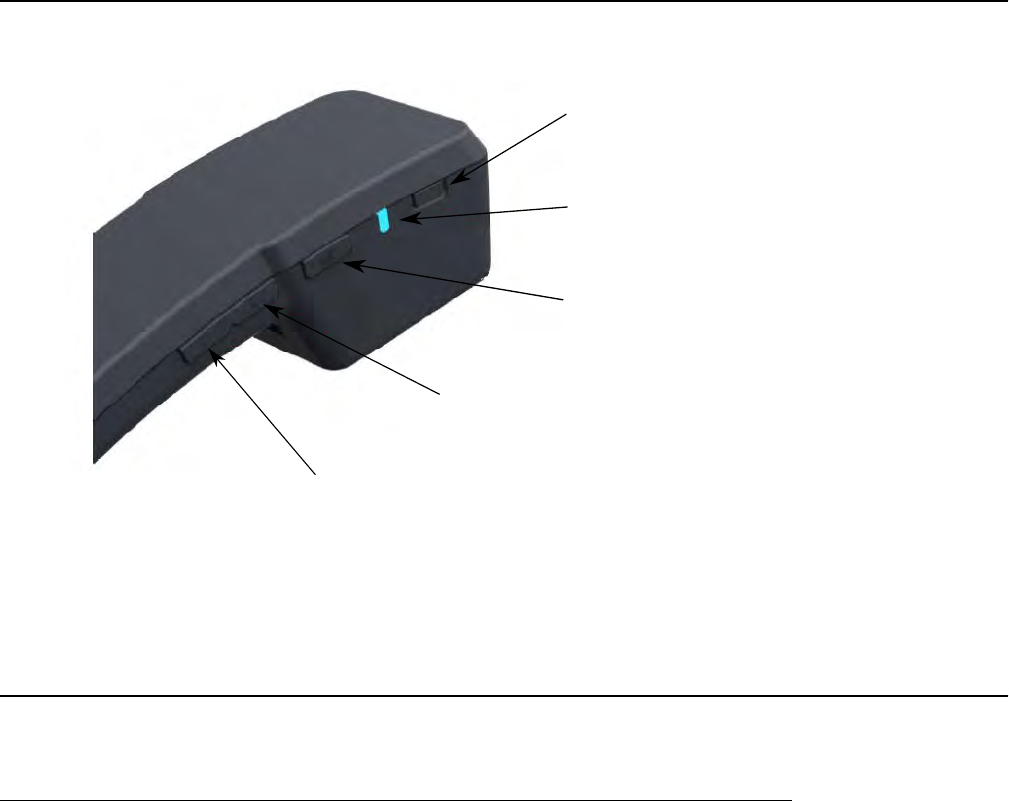
Wireless handset layout1
Power button
LED indicator
Mute
Volume up
Volume down
2
Avaya Vantage Basic screen navigation3
4
Dial pad screen5
The following sections show the Avaya Vantage™ Basic Dial pad screen.6
Navigation
June 2018 Using Avaya Vantage™ and Avaya Vantage™ Basic 28
Avaya - Proprietary. Use pursuant to the terms of your signed agreement or Avaya policy.
DRAFT—May 15, 2018—3:13 PM (UTC)
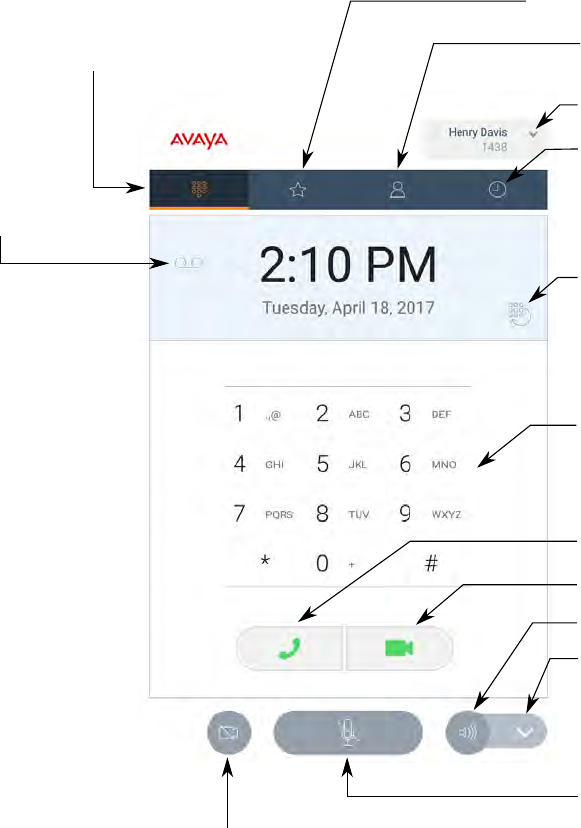
K165 or K175 device1
Dial pad tab
Favorites tab
Contacts tab
Profile settings
Call history tab
Dial pad
Video call
Audio call
On hook button
Mute
Block outgoing video
Redial
Audio device selector
Voice mail
2
Avaya Vantage Basic screen navigation
June 2018 Using Avaya Vantage™ and Avaya Vantage™ Basic 29
Avaya - Proprietary. Use pursuant to the terms of your signed agreement or Avaya policy.
DRAFT—May 15, 2018—3:13 PM (UTC)
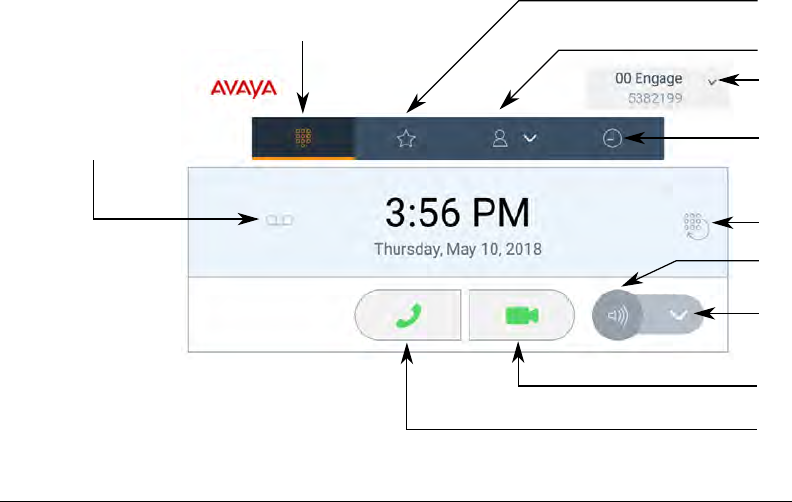
K155 device1
Voice mail
Audio call
Video call
Audio device selector
On hook button
Redial
Call history tab
Profile settings
Contacts tab
Favorites tab
Dial pad tab
2
3
Contacts screen4
The following sections show the Avaya Vantage™ Basic Contacts screen.5
Navigation
June 2018 Using Avaya Vantage™ and Avaya Vantage™ Basic 30
Avaya - Proprietary. Use pursuant to the terms of your signed agreement or Avaya policy.
DRAFT—May 15, 2018—3:13 PM (UTC)
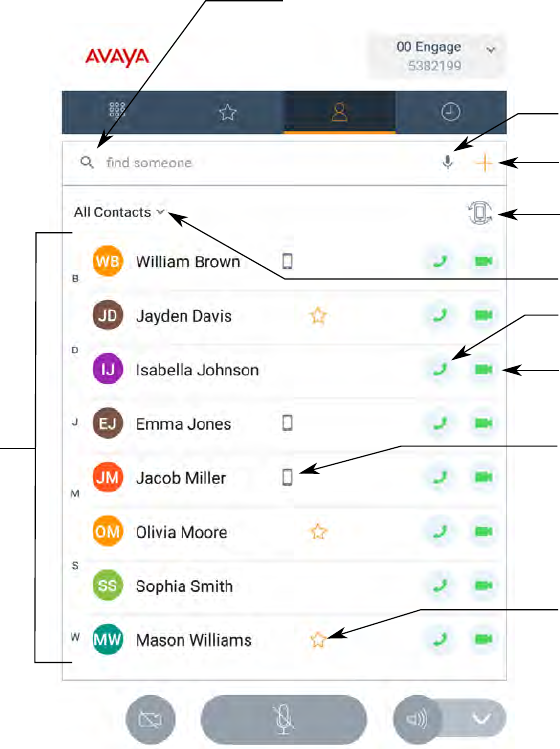
K165 or K175 device1
Contact search
Add new contacts
Audio call
Video call
Contacts
list
Favorite contact
Voice search
Synch contacts
from paired device
Synched contact
Contact filters
2
Avaya Vantage Basic screen navigation
June 2018 Using Avaya Vantage™ and Avaya Vantage™ Basic 31
Avaya - Proprietary. Use pursuant to the terms of your signed agreement or Avaya policy.
DRAFT—May 15, 2018—3:13 PM (UTC)
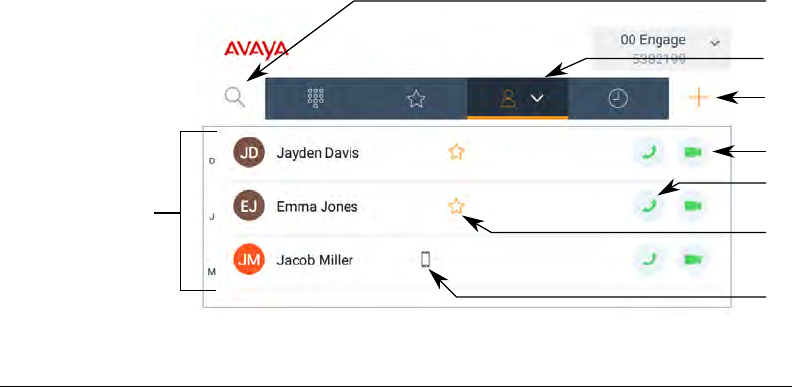
K155 device1
Contacts
list
Contact search
Add contact
Video call
Audio call
Favorite contact
Synched contact
Contact filters
2
3
Call screen4
The following sections show the Avaya Vantage™ Basic Call screen.5
Navigation
June 2018 Using Avaya Vantage™ and Avaya Vantage™ Basic 32
Avaya - Proprietary. Use pursuant to the terms of your signed agreement or Avaya policy.
DRAFT—May 15, 2018—3:13 PM (UTC)
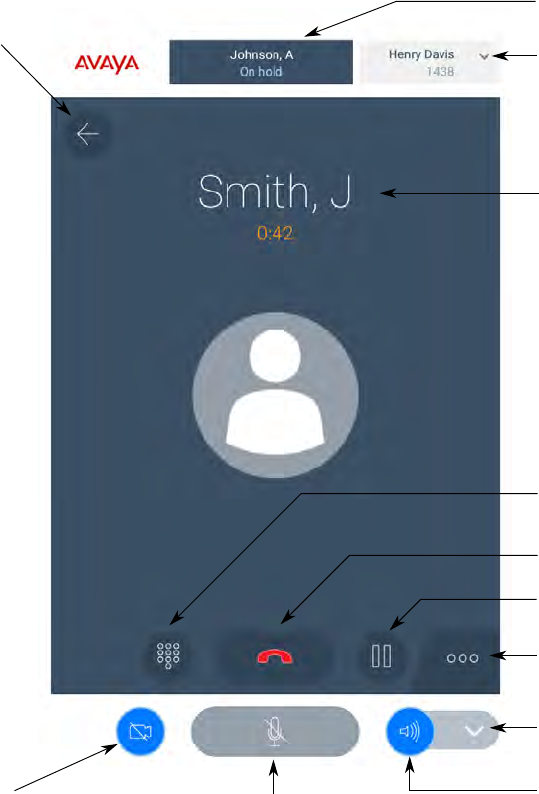
K165 or K175 device1
Back to Main screen
Profile settings
Advanced call options
End call
Hold call
Dial pad
Name of the contact
Mute
On hook button
Block outgoing video
Second call information
Audio device selector
2
Avaya Vantage Basic screen navigation
June 2018 Using Avaya Vantage™ and Avaya Vantage™ Basic 33
Avaya - Proprietary. Use pursuant to the terms of your signed agreement or Avaya policy.
DRAFT—May 15, 2018—3:13 PM (UTC)
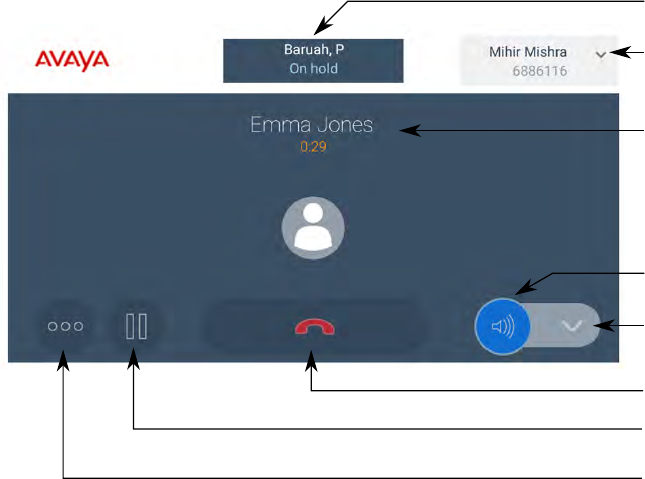
K155 device1
Second call
information
Profile settings
Name of the contact
Speaker or
On hook
Audio device selector
End call
Hold call
Advanced call options
2
Navigation
June 2018 Using Avaya Vantage™ and Avaya Vantage™ Basic 34
Avaya - Proprietary. Use pursuant to the terms of your signed agreement or Avaya policy.
DRAFT—May 15, 2018—3:13 PM (UTC)
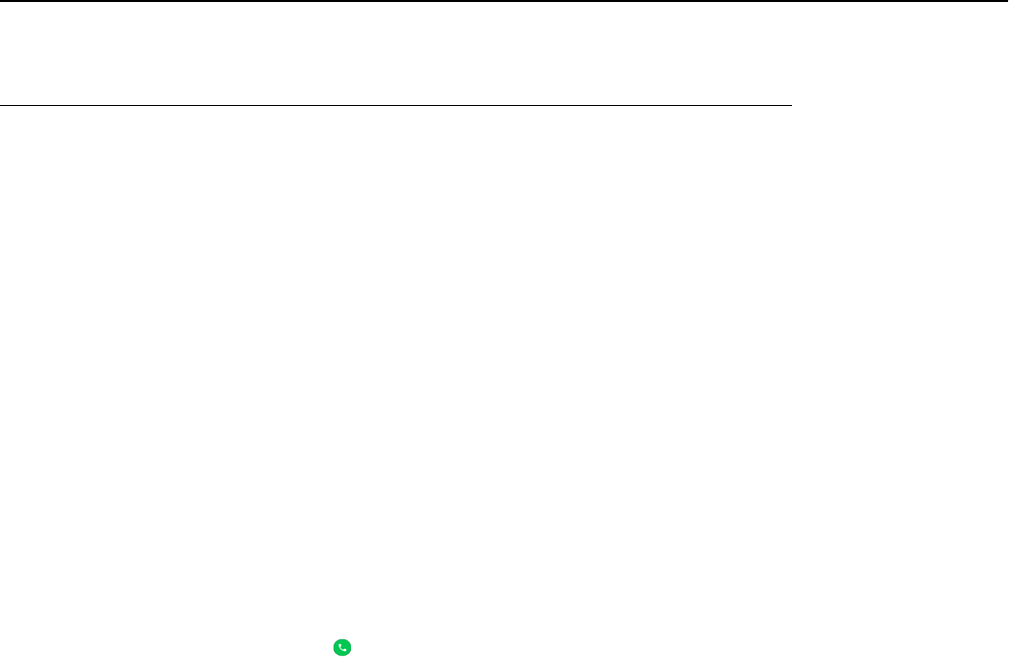
Chapter 5: Call management operations1
You can perform the following key call management tasks:2
• Making audio or video calls3
• Answering audio or video calls4
• Performing call control operations5
• Viewing your call history and missed calls6
• Working with conferences7
Making audio or video calls8
9
Making an emergency call10
About this task11
Use this procedure to make a call to a preconfigured emergency services number. Your system12
administrator can configure the emergency services numbers.13
In the Avaya Aura® environment, you can make an emergency call even when you are logged out14
of Avaya Vantage™ or when Avaya Vantage™ is in the locked state.15
In the IP Office environment, you can make an emergency call only when you are logged in to16
Avaya Vantage™. You cannot make an emergency call from the Login screen. You can make an17
emergency call from the Lock screen if the Lock mode is enabled and an administrator has18
configured emergency numbers in the 46xxspecial.txt file.19
Procedure20
• To make an emergency call from the Login or the Lock screen, in the lower-right corner of the21
screen, tap Emergency call and do one of the following:22
- To automatically dial the preconfigured emergency number with the highest priority, tap23
Auto - dial.24
- To dial one of preconfigured emergency numbers manually, tap Manual dial, enter the25
number and then tap .26
With K165 and K175, you must tap the digits on the screen. With K155, use the physical27
keypad on the device to dial the number.28
June 2018 Using Avaya Vantage™ and Avaya Vantage™ Basic 35
Avaya - Proprietary. Use pursuant to the terms of your signed agreement or Avaya policy.
DRAFT—May 15, 2018—3:13 PM (UTC)
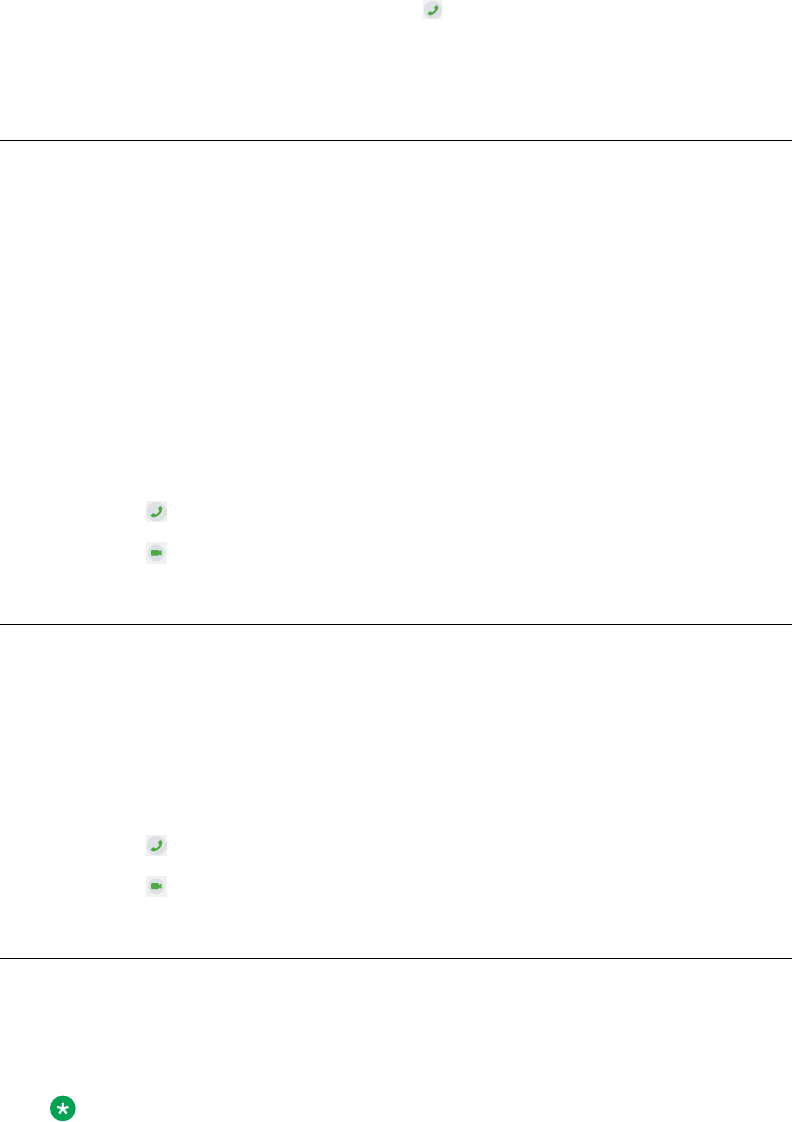
• To make an emergency call from Avaya Vantage™ Basic, on the Dial pad screen, enter the1
emergency number and then tap .2
With K165 and K175, you must tap the digits on the screen. With K155, use the physical3
keypad on the device to dial the number.4
5
Making an audio or video call using the dial pad6
Before you begin7
If you are using a handset, lift the handset from the cradle.8
Procedure9
1. Tap the Dial pad tab.10
2. Enter the telephone number you want to call.11
With K165 and K175, you must tap the digits on the screen. With K155, use the physical12
keypad on the device to dial the number.13
3. Tap one of the following:14
•: To make an audio call.15
•: To make a video call.16
17
Making an audio or video call using contacts18
Procedure19
1. Tap the Contacts tab.20
2. Select the required contact.21
3. Tap one of the following:22
•: To make an audio call.23
•: To make a video call.24
25
Making an audio or video call from your Favorites list26
Before you begin27
Ensure that you have contacts in your Favorites list.28
Note:
On IP Office, you cannot add IP Office personal contacts to your Favorites list.29
Call management operations
June 2018 Using Avaya Vantage™ and Avaya Vantage™ Basic 36
Avaya - Proprietary. Use pursuant to the terms of your signed agreement or Avaya policy.
DRAFT—May 15, 2018—3:13 PM (UTC)
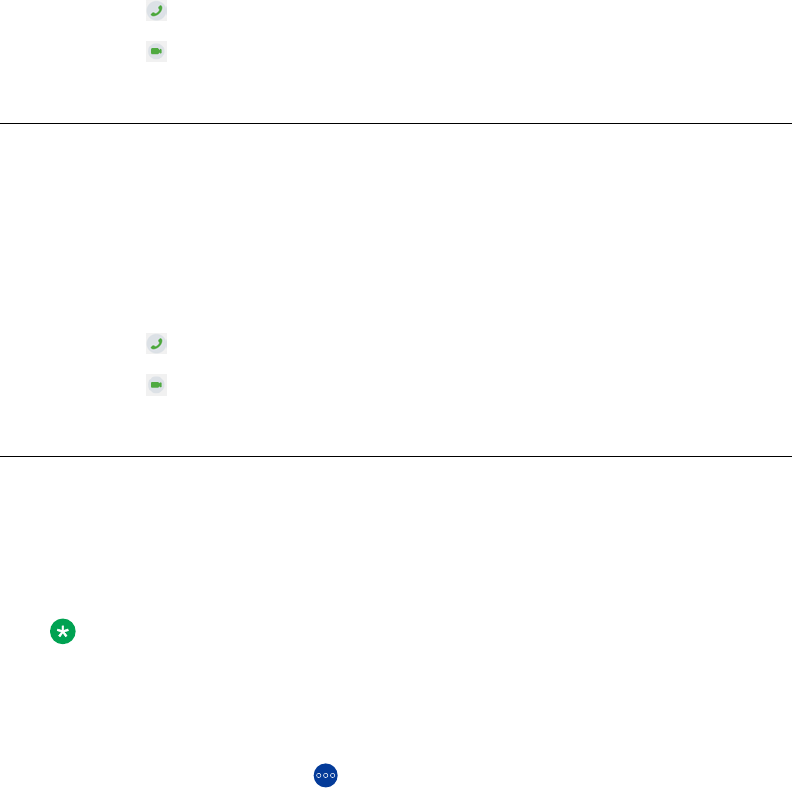
Procedure1
1. Tap the Favorites tab.2
2. Select the required contact.3
3. Tap one of the following:4
•: To make an audio call.5
•: To make a video call.6
7
Making an audio or video call using call history8
Procedure9
1. Tap the Call History tab.10
2. Select the required contact or telephone number.11
3. Tap one of the following:12
•: To make an audio call.13
•: To make a video call.14
15
Making a second call16
About this task17
Use this procedure to make a second call while you are already on a call. You can have up to two18
calls at the same time. When one call is active, the other is placed on hold.19
Note:
For multiple line support to work on IP Office, you must enable the Call Waiting On feature for20
the user account. Otherwise the connection is treated as a single line.21
Procedure22
1. While on a call, tap .23
2. In the Call Features window, tap New Call.24
Avaya Vantage™ Basic places the first call on hold and displays the Dial pad screen.25
3. Do one of the following:26
• Enter the telephone number you want to call.27
With K165 and K175, you must tap the digits on the screen. With K155, use the physical28
keypad on the device to dial the number.29
• In the Contacts tab, select the required contact.30
Making audio or video calls
June 2018 Using Avaya Vantage™ and Avaya Vantage™ Basic 37
Avaya - Proprietary. Use pursuant to the terms of your signed agreement or Avaya policy.
DRAFT—May 15, 2018—3:13 PM (UTC)
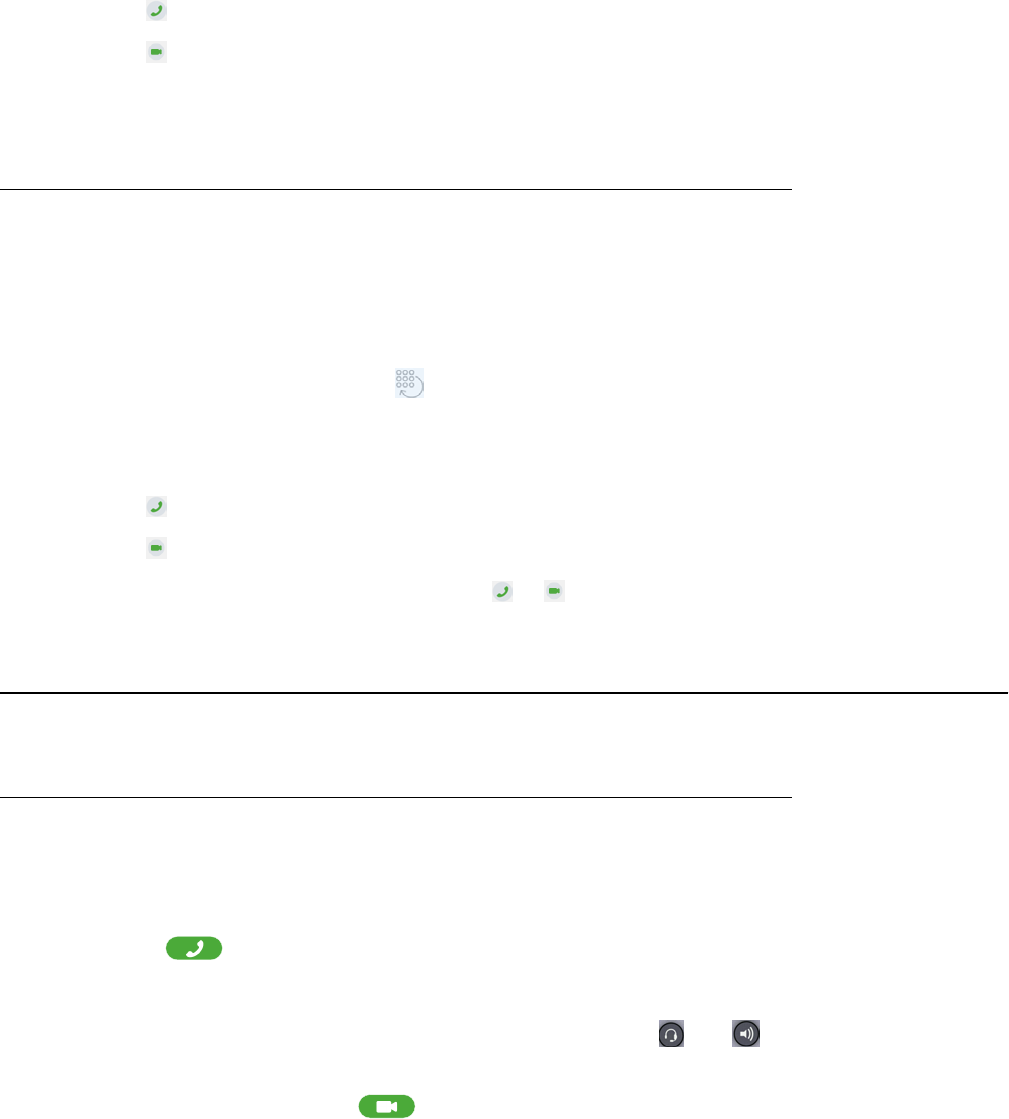
• In the Favorites tab, select the required contact.1
• In the Call History tab, select the required contact or telephone number.2
4. Tap one of the following:3
•: To make an audio call.4
•: To make a video call.5
After the connection is established, the second call becomes the active call. The first call6
remains on hold until you toggle between calls.7
8
Redialing a number9
About this task10
Use this procedure to redial the last dialed number.11
Procedure12
1. On the Dial pad screen, tap .13
Avaya Vantage™ displays the last dialed number on the screen.14
2. Tap one of the following:15
•: To make an audio call.16
•: To make a video call.17
You can also redial by double tapping or .18
Managing calls19
20
Answering or declining an incoming call21
Procedure22
•To answer an audio call, do one of the following:23
-Tap on your screen.24
-Lift the handset from the cradle when you are using a wired or wireless handset.25
With K155, after answering the call, you can also use the and buttons on the device to26
toggle between your headset or speaker phone.27
•To accept a video call, tap .28
Call management operations
June 2018 Using Avaya Vantage™ and Avaya Vantage™ Basic 38
Avaya - Proprietary. Use pursuant to the terms of your signed agreement or Avaya policy.
DRAFT—May 15, 2018—3:13 PM (UTC)
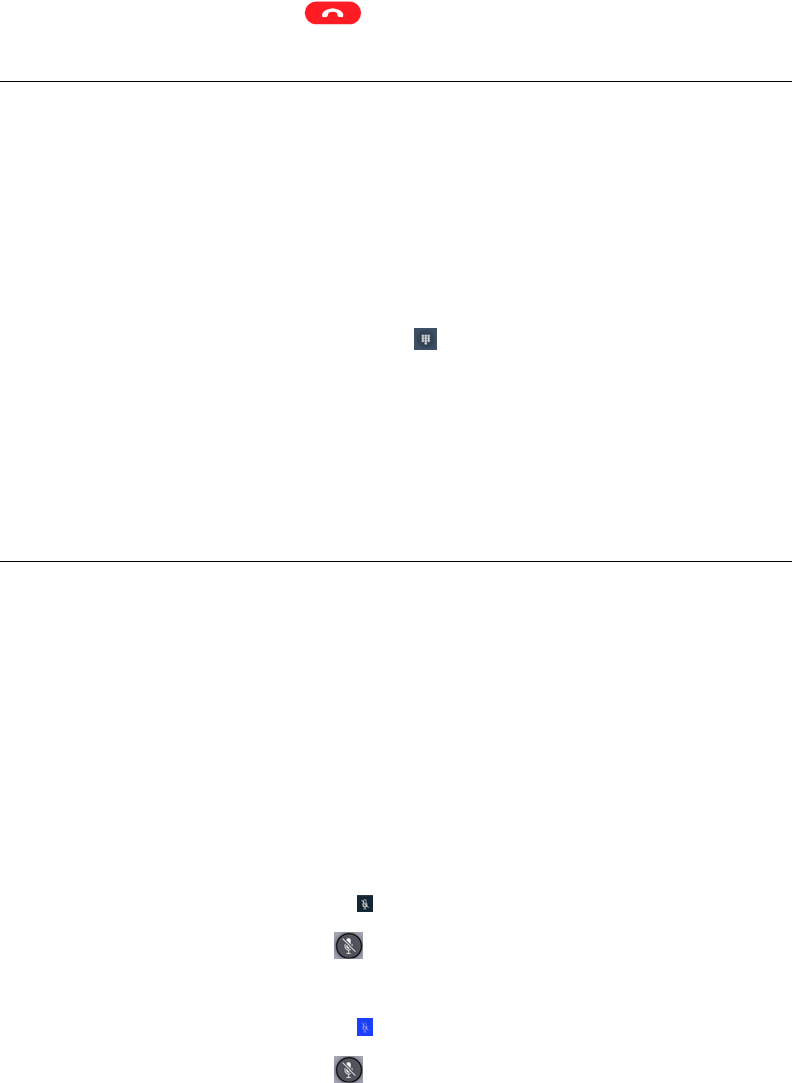
•To decline a call, tap .1
2
Entering digits during a call3
About this task4
Use this procedure if you need to enter DTMF digits during a call. For example, when you check5
your voice mail, you are prompted to enter digits.6
Procedure7
•With K165 and K175, do the following:8
1. While on an active call, tap .9
The application displays the dial pad.10
2. Enter the required digits.11
• With K155, use the physical keypad on the device to enter the required digits.12
On K155, the application does not display the entered digits on the screen.13
14
Muting or unmuting a call15
About this task16
Use this procedure to mute or unmute your microphone during an active call. When you are on17
mute, the other party cannot hear you.18
A muted call gets unmuted automatically when you switch to a different audio device during the19
call. However, you can perform call operations, such as putting the call on hold or resuming the20
call, during a muted call without getting unmuted.21
Procedure22
• To mute yourself during a call:23
- With K165 or K175, tap on the screen.24
-With K155, press the button on the device keypad.25
•To unmute yourself:26
- With K165 or K175, tap .27
-With K155, press the button on the device again.28
•(Optional) On a wireless handset, press the Mute button to mute or unmute yourself.29
When you mute a call on your wireless handset, the application UI does not indicate that the30
call is muted.31
If you disconnect the call without unmuting the wireless handset, the handset remains muted.32
Managing calls
June 2018 Using Avaya Vantage™ and Avaya Vantage™ Basic 39
Avaya - Proprietary. Use pursuant to the terms of your signed agreement or Avaya policy.
DRAFT—May 15, 2018—3:13 PM (UTC)
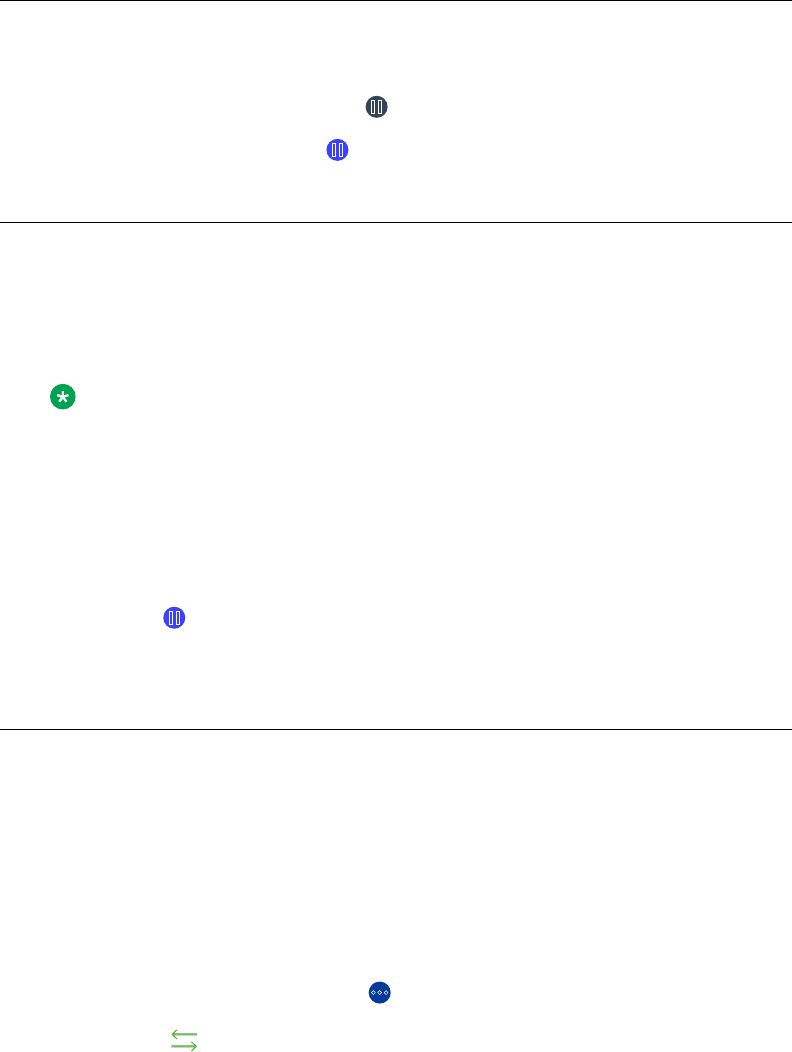
1
Placing a call on hold and resuming the call2
Procedure3
•To place a call on hold, tap .4
•To resume the call, tap .5
6
Toggling between calls7
About this task8
Use this procedure to toggle between two calls when one call is active and the other call is on9
hold.10
Note:
For multiple line support to work on IP Office, you must enable the Call Waiting On feature for11
the user account. Otherwise the connection is treated as a single line.12
Procedure13
1. At the top of the Call screen, tap the label of the held call.14
The application displays the inactive or held call on the Call screen.15
2. Tap .16
The inactive call becomes the active call, and the other call is placed on hold.17
18
Transferring a call19
About this task20
Use this procedure to transfer a call to another number. A direct transfer, as described in this21
procedure, is a blind or unattended transfer. When you perform a blind transfer, you cannot notify22
the other party about the transfer and you cannot return to your original call after starting the23
transfer procedure.24
Procedure25
1. During an active call, tap .26
2. Tap .27
3. Do one of the following:28
• Tap Enter a number and then enter the phone number.29
• Tap Choose a Person and then select the required contact from the Contacts, Call30
History, or Favorites list.31
Call management operations
June 2018 Using Avaya Vantage™ and Avaya Vantage™ Basic 40
Avaya - Proprietary. Use pursuant to the terms of your signed agreement or Avaya policy.
DRAFT—May 15, 2018—3:13 PM (UTC)
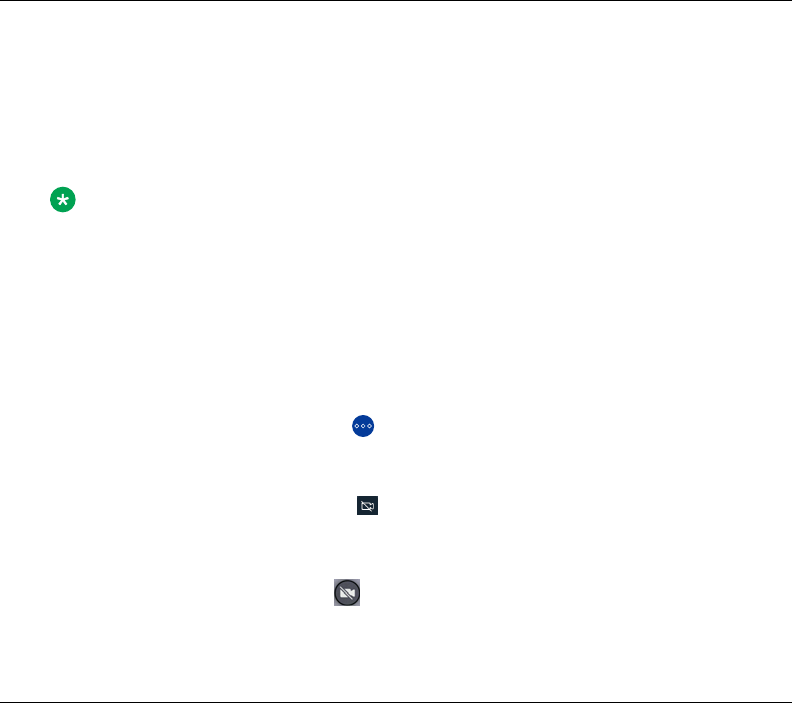
4. Tap Transfer.1
2
Working with video functionality3
About this task4
Use this procedure to start, stop, pause and resume video during a call. When you pause your5
video, the application stops transmitting your video to the other party. When a video is paused,6
you can still receive video from the other party and your audio is still transmitted to the other party.7
Note:
• If you switch to another application while on a video call, video will be stopped. To start8
video again, switch back to Avaya Vantage™ Basic.9
• For privacy reasons, Avaya Vantage™ Basic always pauses outgoing video when the10
other party makes a video call or adds video to an existing call. To transmit your video to11
the other party, you must enable video manually.12
Procedure13
•To start or stop video, tap and then tap Start Video or Stop Video.14
• To pause or mute video:15
-With K165 or K175, tap .16
The icon becomes blue. You can tap this icon again to resume video.17
-With K155, press the .18
Press this button again to resume video.19
20
Selecting an active audio device21
About this task22
By default, Avaya Vantage™ uses speakers to transmit audio. If you have a headset or handset23
connected to your device, you can select which audio device to use in a call.24
Procedure25
• From the Dial pad or Call screen, tap Audio device selector and select the required device26
from the list.27
• To select your wireless handset as an active audio device when on a call, lift the handset28
from the cradle.29
Avaya Vantage™ automatically transfers audio to the wireless handset.30
• To select the device speaker when using a wireless handset, do the following:31
1. Select the device speaker from Audio device selector.32
Managing calls
June 2018 Using Avaya Vantage™ and Avaya Vantage™ Basic 41
Avaya - Proprietary. Use pursuant to the terms of your signed agreement or Avaya policy.
DRAFT—May 15, 2018—3:13 PM (UTC)
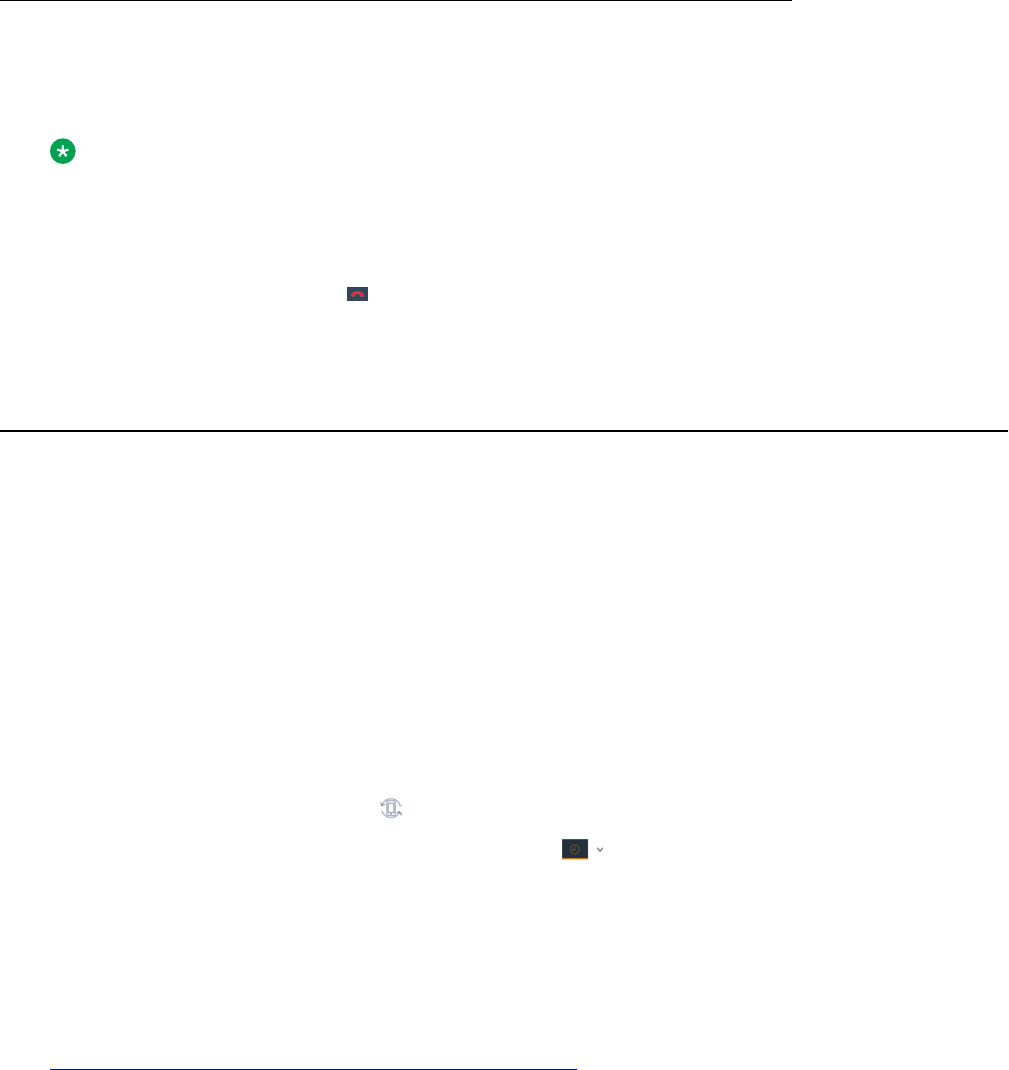
2. Place the handset in its cradle.1
2
Ending a call3
About this task4
Use this procedure to end a call.5
Note:
If you receive an incoming call while on another call, you cannot end the first call until you6
answer or decline the second call.7
Procedure8
• To end an active call, tap on the screen.9
• If you are using a handset, hang up by placing the handset in its cradle.10
Viewing call history11
Procedure12
1. Tap the Call History tab.13
2. Filter the call history using the following options:14
•All Calls15
•Missed Calls16
•Outgoing Calls17
•Incoming Calls18
3. (Optional) To view the call history of the synchronized device:19
•With K165 or K175, tap , which is at the top-right side of the contacts list.20
•With K155, in the filter options drop-down ( ), tap Bluetooth Sync.21
Avaya Vantage™ Basic displays the call history of the synchronized mobile device in the22
Call History tab if:23
• Call history sharing is enabled.24
• The paired mobile device is connected with Avaya Vantage™.25
Related links26
Synchronizing contacts and call history over Bluetooth on page 4827
Call management operations
June 2018 Using Avaya Vantage™ and Avaya Vantage™ Basic 42
Avaya - Proprietary. Use pursuant to the terms of your signed agreement or Avaya policy.
DRAFT—May 15, 2018—3:13 PM (UTC)
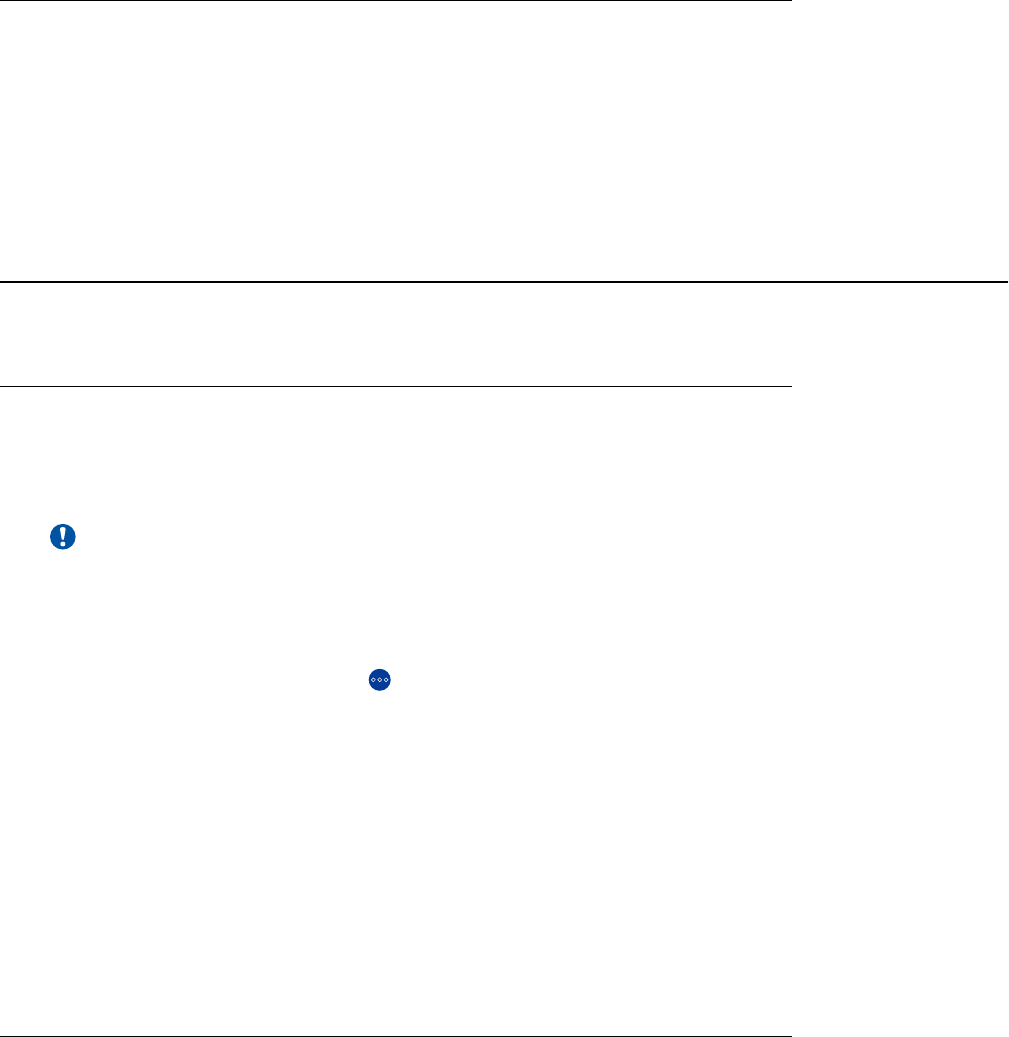
1
Deleting all call information2
Procedure3
1. Tap the Call history tab.4
2. Filter the call history and select Clear All Calls.5
3. Tap Delete in the Confirmation dialog box.6
Working with conference calls7
8
Starting a conference call9
About this task10
Use this procedure to start an audio or video conference call.11
Important:
This procedure does not apply to IP Office deployments. With IP Office, you can only merge12
calls to create a conference call. Video conference is also not supported with IP Office.13
Procedure14
1. During an active call, tap .15
2. In the Call Features window, tap Add Someone.16
3. Do one of the following:17
• Tap Enter a number and then enter the phone number.18
• Tap Choose a Person and then select the required contact from the Contacts, Call19
History, or Favorites list.20
4. Tap Add Someone.21
A call is placed to the selected participant. When the participant answers, the conference22
starts.23
24
Merging calls to create a conference call25
About this task26
Use this procedure to merge two calls to create a conference call.27
Working with conference calls
June 2018 Using Avaya Vantage™ and Avaya Vantage™ Basic 43
Avaya - Proprietary. Use pursuant to the terms of your signed agreement or Avaya policy.
DRAFT—May 15, 2018—3:13 PM (UTC)

Before you begin1
You must have two ongoing calls.2
Procedure3
1. From the Call screen, tap .4
2. Tap to merge both calls into a conference call.5
Call management operations
June 2018 Using Avaya Vantage™ and Avaya Vantage™ Basic 44
Avaya - Proprietary. Use pursuant to the terms of your signed agreement or Avaya policy.
DRAFT—May 15, 2018—3:13 PM (UTC)

Chapter 6: Contact management operations1
Adding a contact2
About this task3
Use this procedure to add new contacts in Avaya Vantage™ Basic. You can save a personal4
contact in the local storage or to the enterprise directory. In the IP Office environment, you can add5
a personal contact to the IP Office personal directory.6
In Avaya Vantage™ Basic, you can modify and delete personal contacts added to the enterprise or7
IP Office personal directory. Any modification to such contacts is synchronized automatically8
between Avaya Vantage™ Basic and the enterprise or IP Office personal directory.9
Note that Avaya Vantage™ deletes local contacts data when another user logs in to the device. To10
store local contacts data, enable data backup and provide a backup account in the Settings11
menu.12
Procedure13
1. Tap the Contacts tab.14
2. Tap .15
3. Choose one of the following options:16
•Local Contact: To store the contact locally on the device.17
•Enterprise Contact: To add the contact to the Avaya Aura® enterprise directory.18
•Personal Contact: To add the contact to the IP Office personal directory.19
Either the Enterprise Contact or the Personal Contact option is available depending on20
the environment in which the device is installed.21
4. In the First Name and Last Name fields, enter the name of the new contact.22
5. Do the following to add the phone number of the contact:23
a. Tap Add phone number.24
b. In the drop-down list, select the appropriate phone category.25
c. In the Phone field, enter the phone number.26
You must provide at least one phone number for each contact.27
Use the on-screen keyboard to enter contact details. Do not use the physical keypad on28
the K155 device.29
June 2018 Using Avaya Vantage™ and Avaya Vantage™ Basic 45
Avaya - Proprietary. Use pursuant to the terms of your signed agreement or Avaya policy.
DRAFT—May 15, 2018—3:13 PM (UTC)

6. (Optional) Repeat the previous step to add more phone numbers for the contact.1
7. (Optional) Add other information about the contact, such as the job title, company name,2
and address.3
8. Tap Done.4
The contacts and their details are displayed in your Contacts list.5
Editing a contact6
About this task7
Use this procedure to edit the details of a contact.8
You can modify local contacts and personal contacts added to the enterprise or IP Office personal9
directory. Any modification to personal contacts is synchronized automatically between Avaya10
Vantage™ Basic and the enterprise or IP Office personal directory.11
Procedure12
1. Tap the Contacts tab.13
2. In the contacts list, tap the contact that you want to edit.14
3. On the Contact Details page, tap Edit.15
4. Tap the field that you want to edit.16
5. Use the on-screen keyboard to modify the information.17
6. Tap Done.18
Deleting a contact19
About this task20
Use this procedure to delete a contact from the contacts list.21
You can delete local contacts and personal contacts added to the Avaya Aura® enterprise or IP22
Office personal directory.23
Procedure24
1. Tap the Contacts tab.25
2. In the contacts list, tap the contact that you want to delete.26
3. On the Contact Details page, tap Delete.27
4. Tap Yes to confirm the action.28
Contact management operations
June 2018 Using Avaya Vantage™ and Avaya Vantage™ Basic 46
Avaya - Proprietary. Use pursuant to the terms of your signed agreement or Avaya policy.
DRAFT—May 15, 2018—3:13 PM (UTC)

Searching for a contact1
About this task2
Use this procedure to search for a contact.3
In the IP Office environment, IP Officesystem contacts are visible only through search.4
Procedure5
1. Tap the Contacts tab.6
2. On K155, tap the icon.7
3. In the Search field, start typing the name of the contact that you want to look for.8
The application displays all relevant contacts.9
10
IP Office contact search options11
In the IP Office environment, Avaya Vantage™ Basic and the standard Contacts application ( )12
available on the Avaya Vantage™ device support centralized IP Office directory contact search,13
which includes the following:14
• IP Office system contacts across a small community network (SCN).15
• IP Office hunt group contacts across a small community network (SCN).16
• IP Office external contacts in the LDAP, system, and HTTP directories configured in IP Office.17
Setting contact display options18
About this task19
Use this procedure to modify how contact names are displayed in the Contacts list. Contacts can20
be displayed with the first name first or with the last name first.21
Procedure22
1. In Avaya Vantage™ Basic, tap Extension > User Settings.23
2. Tap Application.24
3. In Display preferences, tap Name display preferences and then select one of the25
following options:26
•First Name First: To display the contact names with the first name first followed by the27
last name.28
•Last Name First: To display the contact names with the last name first followed by the29
first name.30
Searching for a contact
June 2018 Using Avaya Vantage™ and Avaya Vantage™ Basic 47
Avaya - Proprietary. Use pursuant to the terms of your signed agreement or Avaya policy.
DRAFT—May 15, 2018—3:13 PM (UTC)

4. Tap Name sort preferences and then select one of the following options:1
•First Name First: To sort the contact list based on the first name.2
•Last Name First: To sort the contact list based on the last name.3
Setting a contact as a favorite4
About this task5
Use this procedure to add a contact to your Favorites list.6
Note:
In the IP Office environment, you cannot add IP Office personal contacts to you Favorites list.7
Procedure8
1. Tap the Contacts tab.9
2. Tap the appropriate contact.10
3. In Contact Details, tap , which is beside the contact’s name.11
Synchronizing contacts and call history over Bluetooth12
About this task13
Use this procedure to synchronize your mobile phone’s contacts and call history with the Avaya14
Vantage™ device over Bluetooth. After the synchronization, you can access all contacts and call15
history of the paired phone on your Avaya Vantage™ device when the devices are connected.16
Contacts from all accounts on your mobile phone, including Google and Facebook, are shared17
with the Avaya Vantage™ device, but only so long as the devices remain connected. If Bluetooth18
connectivity is lost, the shared phone contacts and call history data is automatically deleted from19
the Avaya Vantage™ device.20
Procedure21
To pair a mobile phone with the Avaya Vantage™ device, do the following:22
1. On the mobile phone and the Avaya Vantage™ device, turn on Bluetooth.23
2. On the Avaya Vantage™ device, tap Settings > Bluetooth.24
3. In Available devices, tap the name of the mobile phone.25
4. On the screens of both devices, do the following:26
a. Verify the displayed passcode.27
b. Select the option to allow the paired device to access the contacts and call history.28
Contact management operations
June 2018 Using Avaya Vantage™ and Avaya Vantage™ Basic 48
Avaya - Proprietary. Use pursuant to the terms of your signed agreement or Avaya policy.
DRAFT—May 15, 2018—3:13 PM (UTC)

c. Tap Pair.1
To synchronize and share contacts and call history from the paired phone, do the following:2
5. On the Avaya Vantage™ device, tap Settings > Bluetooth.3
6. In Bluetooth Contact & Call History Sharing, enable the following:4
•Contact Sharing5
•Call History Sharing6
The synchronized contacts become available through the following:7
• The Contacts tab in the Avaya Vantage™ Basic or Avaya Equinox® application.8
• The standard Contacts application on the Avaya Vantage™ device.9
The synchronized call history is available on the Call History tab of the Avaya Vantage™
10
Basic application.11
Note:
Any third-party application that is capable of displaying call logs from the default12
telephony application can display the call history from the synchronized mobile device.13
After the Bluetooth connection is disconnected, if such application is caching the call14
history and not clearing the cache, the call history from the synchronized device is15
retained.16
Filtering contacts17
Procedure18
1. Tap the Contacts tab.19
2. Filter the contacts using the following options:20
•All Contacts: To view the local and enterprise contacts.21
•Enterprise Contacts: To view Avaya Aura® enterprise contacts.22
•Personal Contacts: To view IP Office personal contacts.23
•Local Contacts: To view the contacts stored in the local storage, such as Google or24
Exchange contacts.25
3. (Optional) To view the contacts of the synchronized device:26
•With K165 or K175, tap , which is at the top-right side of the contacts list.27
•With K155, in the contacts filter drop-down ( ), tap Bluetooth Sync.28
Avaya Vantage™ Basic displays the contacts of the synchronized device under All Contacts29
and Local Contacts if:30
• Contact sharing is enabled.31
Filtering contacts
June 2018 Using Avaya Vantage™ and Avaya Vantage™ Basic 49
Avaya - Proprietary. Use pursuant to the terms of your signed agreement or Avaya policy.
DRAFT—May 15, 2018—3:13 PM (UTC)

• The paired device is connected with Avaya Vantage™.1
Related links2
Synchronizing contacts and call history over Bluetooth on page 483
Contact management operations
June 2018 Using Avaya Vantage™ and Avaya Vantage™ Basic 50
Avaya - Proprietary. Use pursuant to the terms of your signed agreement or Avaya policy.
DRAFT—May 15, 2018—3:13 PM (UTC)
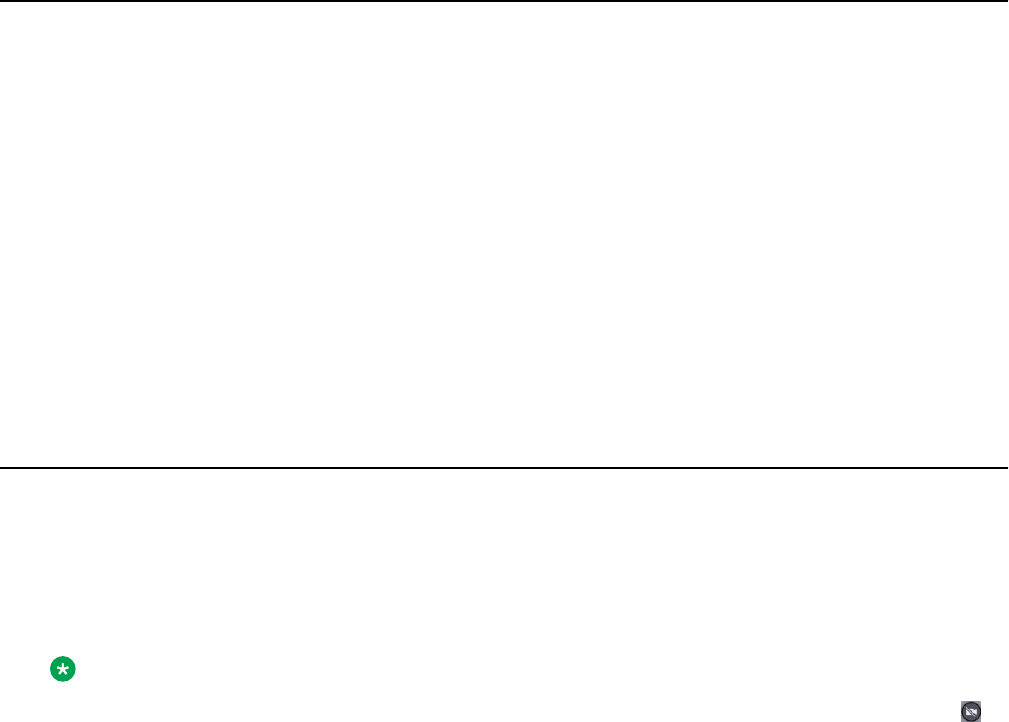
Chapter 7: Customization1
Modifying the ring tone2
About this task3
Use this procedure to change the default ring tone for incoming calls in Avaya Vantage™ Basic.4
You can select from a list of built-in and administrator-downloaded ring tones.5
You can change the ring tone in the telephony application but not on the Avaya Vantage™device.6
Procedure7
1. In Avaya Vantage™ Basic, tap Extension > User Settings.8
2. Tap Audio/Video.9
3. In Ring Preferences, tap Choose Ringtone.10
4. Select the new ring tone and tap OK.11
Disabling video using the privacy shutter12
About this task13
On the K175 device, you can physically prevent the camera from capturing video using a privacy14
shutter. When you close the shutter, the camera is still on, but it only transmits a black15
background. The camera LED is also on, indicating that the camera is working.16
Note:
The K155 device does not include a physical shutter. You can use the video mute button ( )17
to disable video.18
Procedure19
•To disable video capturing, shift the lever located above the camera to the leftmost position20
so that the camera is entirely covered with the shutter.21
If the shutter does not cover the entire camera, the camera might be able to capture partial22
video.23
• To enable video capturing, shift the lever to the rightmost position so that the shutter does not24
cover the camera.25
June 2018 Using Avaya Vantage™ and Avaya Vantage™ Basic 51
Avaya - Proprietary. Use pursuant to the terms of your signed agreement or Avaya policy.
DRAFT—May 15, 2018—3:13 PM (UTC)

Changing the wallpaper1
About this task2
Use this procedure to change the default wallpaper on the Avaya Vantage™ device. You can select3
an administrator-downloaded wallpaper or any other image file available on the device.4
Procedure5
1. Tap Settings > Display.6
2. Tap Wallpaper.7
3. Tap one of the following options available on the device:8
•Live wallpapers9
•Photos10
•Wallpapers11
4. Select the new wallpaper and tap Set wallpaper.12
Customization
June 2018 Using Avaya Vantage™ and Avaya Vantage™ Basic 52
Avaya - Proprietary. Use pursuant to the terms of your signed agreement or Avaya policy.
DRAFT—May 15, 2018—3:13 PM (UTC)
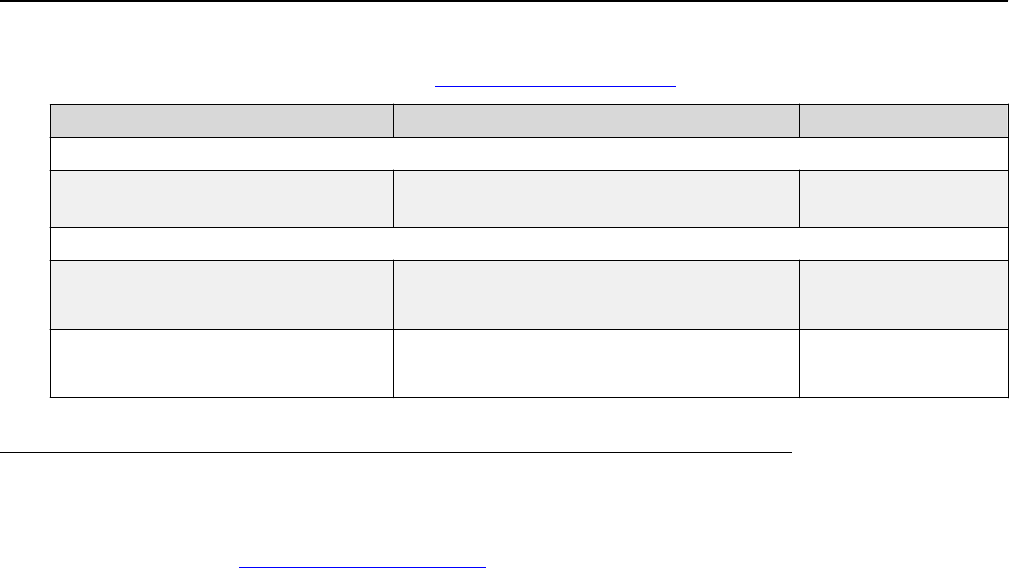
Chapter 8: Resources1
Documentation2
See the following related documents at http://support.avaya.com.3
Title Use this document to: Audience
Deploying
Installing and Administering Avaya
Vantage™
Install, configure, and maintain Avaya
Vantage™.
Implementation
personnel
Using
Using Avaya Equinox® for Android,
iOS, Mac, and Windows
Set up and use Avaya Equinox® clients. • End users
• Support personnel
Using Avaya Vantage™ Open Use Avaya Vantage™• End users
• Support personnel
4
Finding documents on the Avaya Support website5
Procedure6
1. Navigate to http://support.avaya.com/.7
2. At the top of the screen, type your username and password and click Login.8
3. Click Support by Product > Documents.9
4. In Enter your Product Here, type the product name and then select the product from the10
list.11
5. In Choose Release, select an appropriate release number.12
6. In the Content Type filter, click a document type, or click Select All to see a list of all13
available documents.14
For example, for user guides, click User Guides in the Content Type filter. The list15
displays the documents only from the selected category.16
7. Click Enter.17
June 2018 Using Avaya Vantage™ and Avaya Vantage™ Basic 53
Avaya - Proprietary. Use pursuant to the terms of your signed agreement or Avaya policy.
DRAFT—May 15, 2018—3:13 PM (UTC)
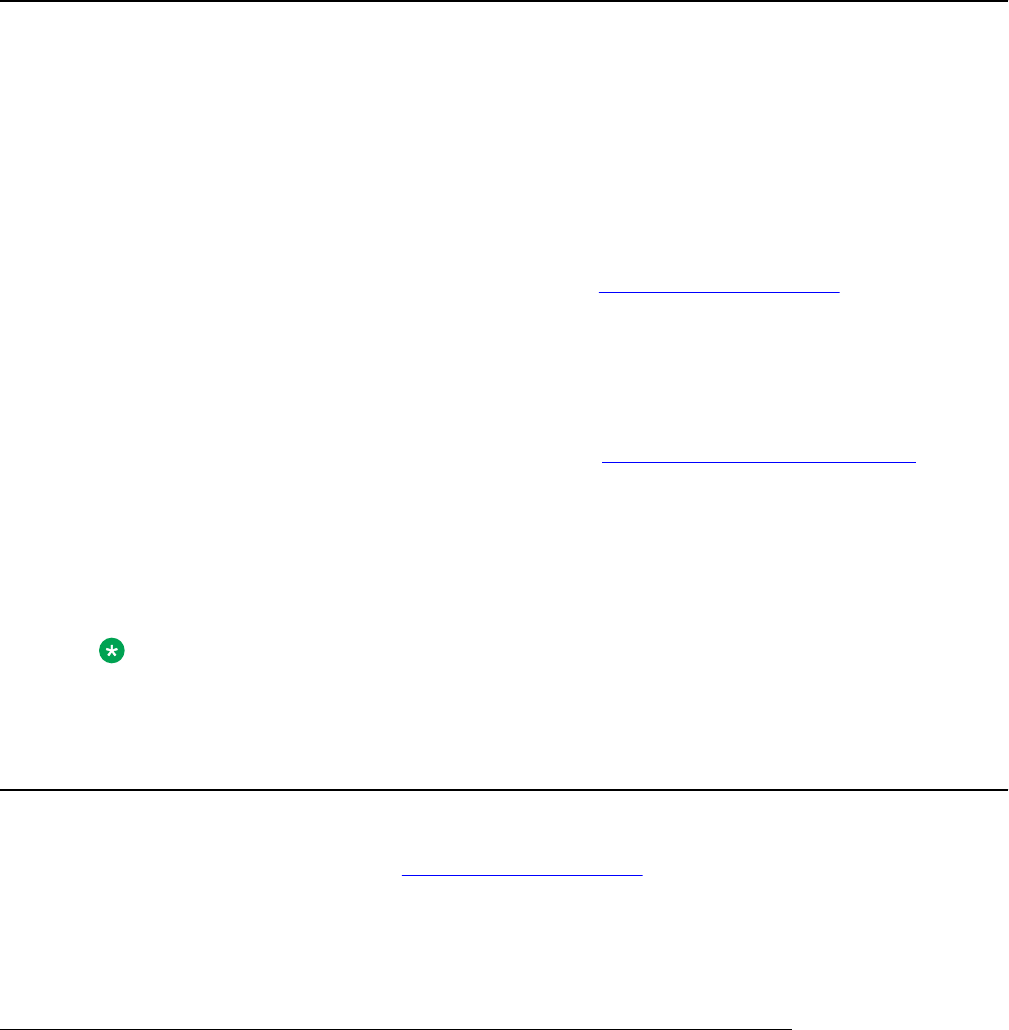
Viewing Avaya Mentor videos1
Avaya Mentor videos provide technical content on how to install, configure, and troubleshoot2
Avaya products.3
About this task4
Videos are available on the Avaya Support website, listed under the video document type, and on5
the Avaya-run channel on YouTube.6
Procedure7
• To find videos on the Avaya Support website, go to http://support.avaya.com and perform one8
of the following actions:9
- In Search, type Avaya Mentor Videos to see a list of the available videos.10
- In Search, type the product name. On the Search Results page, select Video in the11
Content Type column on the left.12
• To find the Avaya Mentor videos on YouTube, go to www.youtube.com/AvayaMentor and13
perform one of the following actions:14
-Enter a key word or key words in the Search Channel to search for a specific product or15
topic.16
- Scroll down Playlists, and click the name of a topic to see the available list of videos17
posted on the website.18
Note:
Videos are not available for all products.19
Support20
Go to the Avaya Support website at http://support.avaya.com for the most up-to-date21
documentation, product notices, and knowledge articles. You can also search for release notes,22
downloads, and resolutions to issues. Use the online service request system to create a service23
request. Chat with live agents to get answers to questions, or request an agent to connect you to a24
support team if an issue requires additional expertise.25
26
Using the Avaya InSite Knowledge Base27
The Avaya InSite Knowledge Base is a web-based search engine that provides:28
• Up-to-date troubleshooting procedures and technical tips29
• Information about service packs30
• Access to customer and technical documentation31
Resources
June 2018 Using Avaya Vantage™ and Avaya Vantage™ Basic 54
Avaya - Proprietary. Use pursuant to the terms of your signed agreement or Avaya policy.
DRAFT—May 15, 2018—3:13 PM (UTC)

• Information about training and certification programs1
• Links to other pertinent information2
If you are an authorized Avaya Partner or a current Avaya customer with a support contract, you3
can access the Knowledge Base without extra cost. You must have a login account and a valid4
Sold-To number.5
Use the Avaya InSite Knowledge Base for any potential solutions to problems.6
1. Go to http://www.avaya.com/support.7
2. Log on to the Avaya website with a valid Avaya user ID and password.8
The system displays the Avaya Support page.9
3. Click Support by Product > Product Specific Support.10
4. In Enter Product Name, enter the product, and press Enter.11
5. Select the product from the list, and select a release.12
6. Click the Technical Solutions tab to see articles.13
7. Select relevant articles.14
Support
June 2018 Using Avaya Vantage™ and Avaya Vantage™ Basic 55
Avaya - Proprietary. Use pursuant to the terms of your signed agreement or Avaya policy.
DRAFT—May 15, 2018—3:13 PM (UTC)

Index
A
active call
entering digits ............................................................... 39
add a contact ....................................................................... 45
answering a call ................................................................... 38
Avaya Smart Lock ................................................................16
enabling ........................................................................ 17
Avaya Vantage Basic
installing ........................................................................14
supported features ........................................................10
Avaya Vantage device layout
K155 ............................................................................. 24
K165 and K175 .............................................................22
Avaya Vantage overview ........................................................9
C
call history
deleting ......................................................................... 43
viewing ..........................................................................42
call management ................................................................. 35
calls
adding video to a call ....................................................41
answering ..................................................................... 38
ending ...........................................................................42
making a call using a call history .................................. 37
making a call using contacts .........................................36
making a call using dial pad ......................................... 36
making a call using favorites ........................................ 36
making an emergency call ............................................35
making a second call .................................................... 37
toggling between calls .................................................. 40
transferring ................................................................... 40
call transfer
unattended transfer ...................................................... 40
change history ....................................................................... 8
changing default ring tone ................................................... 51
changing wallpaper ..............................................................52
conference call .....................................................................43
merging calls into conference .......................................43
connecting
wireless handset ...........................................................19
connectors and controls .......................................................25
contacts
adding a contact ........................................................... 45
adding to favorites ........................................................ 48
deleting a contact ......................................................... 46
editing a contact ........................................................... 46
filtering .......................................................................... 49
making a call using contacts .........................................36
searching ...................................................................... 47
contacts and call history
contacts and call history (continued)
synchronizing ................................................................48
contact search
IP Office ........................................................................47
D
declining a call ..................................................................... 38
delete the call history ........................................................... 43
deleting a contact .................................................................46
device layout ........................................................................22
Avaya Vantage K155 .................................................... 24
K165 and K175 standard Avaya Vantage device ......... 22
disabling video ..................................................................... 51
display
changing wallpaper .......................................................52
document changes ................................................................ 8
DTMF digits ......................................................................... 39
E
editing a contact ...................................................................46
emergency call .....................................................................35
enabling
Avaya Smart Lock .........................................................17
F
features ................................................................................10
G
Google Play applications ..................................................... 13
H
handset
wireless .........................................................................19
I
ignoring a call .......................................................................38
InSite Knowledge Base ........................................................54
installing applications ...........................................................14
IP Office contact search .......................................................47
L
layout
Avaya Vantage K155 .................................................... 24
K165 and K175 standard Avaya Vantage device ......... 22
June 2018 Using Avaya Vantage™ and Avaya Vantage™ Basic 56
Avaya - Proprietary. Use pursuant to the terms of your signed agreement or Avaya policy.
DRAFT—May 15, 2018—3:13 PM (UTC)

legal notices .............................................................................
locking ..................................................................................15
locking when Smart Lock is enabled ................................... 19
logging in ............................................................................. 15
logging out ........................................................................... 15
M
making a call
using call history ........................................................... 37
using contacts list ......................................................... 36
using dial pad ............................................................... 36
using favorites list ......................................................... 36
making a call using contacts ................................................36
making an emergency call ................................................... 35
making a second call ........................................................... 37
merging calls into conference .............................................. 43
muting a call .........................................................................39
N
new in this release ............................................................... 13
P
physical layout ..................................................................... 22
placing a call on hold ........................................................... 40
ports .....................................................................................25
R
redialing a number ............................................................... 38
rejecting a call ......................................................................38
related documentation ......................................................... 53
resuming a call .....................................................................40
ring tone
changing default ring tone ............................................ 51
S
searching contacts ...............................................................47
second call ...........................................................................37
select active audio device ....................................................41
setting contact display options .............................................47
support .................................................................................54
synchronizing contacts and call history ............................... 48
T
third party applications .........................................................13
toggling calls ........................................................................ 40
trusted device
changing ....................................................................... 18
removing .......................................................................18
turn on the wireless handset ................................................20
U
unlocking ..............................................................................15
unmuting a call .....................................................................39
V
video
adding video to a call ....................................................41
blocking and resuming ..................................................41
disabling ....................................................................... 51
videos .................................................................................. 54
viewing call history ...............................................................42
W
wireless handset .................................................................. 19
features .........................................................................11
layout ............................................................................ 28
LED indication .............................................................. 12
turning on and off ..........................................................20
Index
June 2018 Using Avaya Vantage™ and Avaya Vantage™ Basic 57
Avaya - Proprietary. Use pursuant to the terms of your signed agreement or Avaya policy.
DRAFT—May 15, 2018—3:13 PM (UTC)